
commonplace-bot
An LLM augmented commonplace book, available for public viewing
Stars: 54
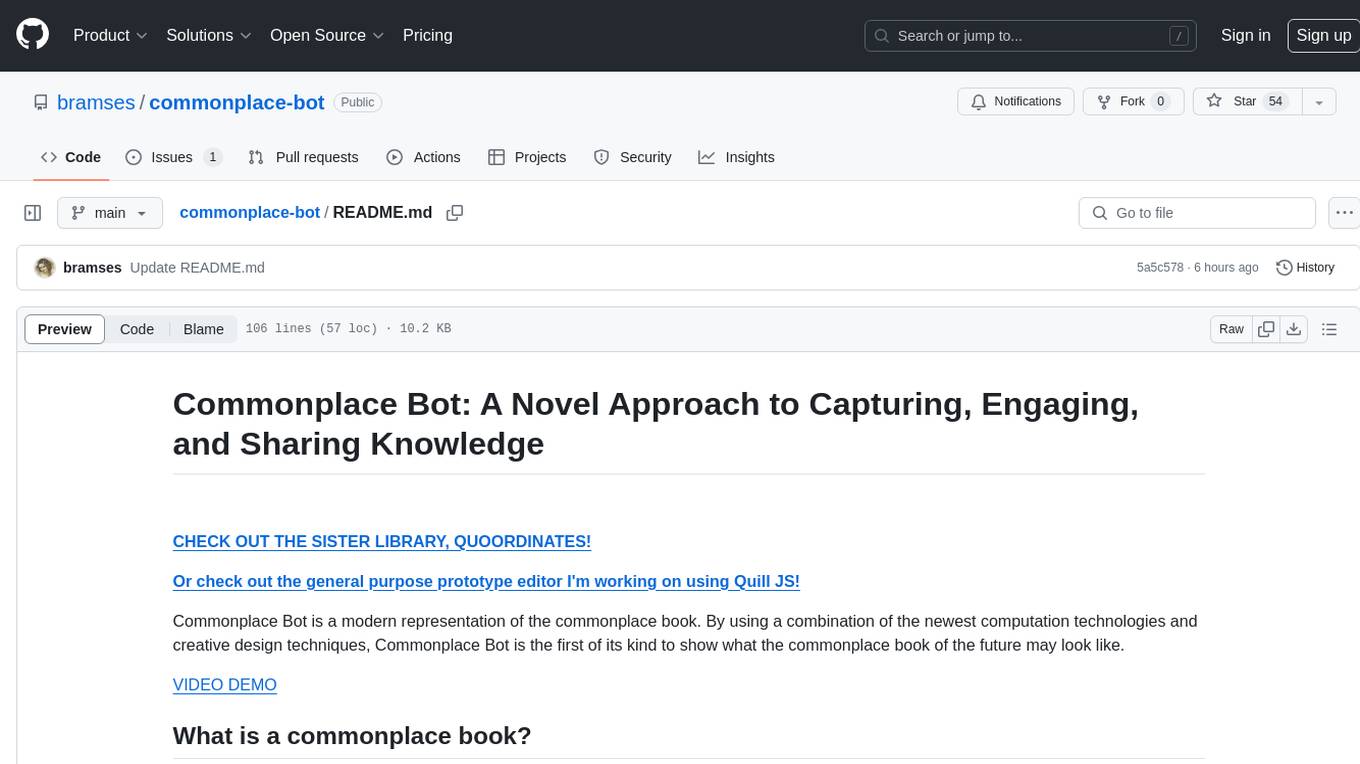
Commonplace Bot is a modern representation of the commonplace book, leveraging modern technological advancements in computation, data storage, machine learning, and networking. It aims to capture, engage, and share knowledge by providing a platform for users to collect ideas, quotes, and information, organize them efficiently, engage with the data through various strategies and triggers, and transform the data into new mediums for sharing. The tool utilizes embeddings and cached transformations for efficient data storage and retrieval, flips traditional engagement rules by engaging with the user, and enables users to alchemize raw data into new forms like art prompts. Commonplace Bot offers a unique approach to knowledge management and creative expression.
README:
CHECK OUT THE SISTER LIBRARY, QUOORDINATES!
Or check out the general purpose prototype editor I'm working on using Quill JS!
Commonplace Bot is a modern representation of the commonplace book. By using a combination of the newest computation technologies and creative design techniques, Commonplace Bot is the first of its kind to show what the commonplace book of the future may look like.
For millennia, people have kept commonplace books to capture, engage, and share knowledge. The commonplace book is a notebook where people write down quotes, ideas, and other information that they want to remember. It has gone by many names historically: zibaldone, zettelkasten, florilegium, and more. But all commonplace books have served roughly the same purpose: to serve as both an external memory and compute augmentation for human ideas. They are slightly seperate from diaries and journals, which are more focused on capturing the author's thoughts and feelings. Commonplace books are more focused on capturing ideas as raw material, and then transforming them into something new.
Before we talk about Commonplace Bot, let's talk about the history of the commonplace book and its modern implementations.
The first layer of the commonplace book is the book itself, the raw collection of ideas. Whether the author prefers paper or digital capture they follow the same basic principles: the author of the commonplace book collects ideas, quotes, and other information that they want to remember. The author can then organize these ideas into a structure that makes sense to them. This structure can be as simple as a table of contents, or as complex as a full-blown taxonomy. The author can then add metadata to each idea to help them find it later. This metadata can be as simple as a date, or as complex as a full-blown ontology like complex tagging systems. Next, many authors then add their own thoughts and ideas to each idea, and link ideas together in a bid to increase the utility of any particular node of knowledge. This is the basic structure of the commonplace book.
Modern techniques like the Zettelkasten and Second Brain movements have focused on making the capture process as efficient as possible. Thanks to apps like Notion, Obsidian, Readwise, etc. eliminating friction, the endgame idea is that the commonplace book will become a natural extension of the author's mind. The author will be able to capture ideas as they come, and then organize them in a way that makes sense to them.
Engaging with the data from the capture section in the commonplace book is all about strategy and triggers. Strategies include: spaced repetition, tickler files, exhaustive table of contents, etc. Triggers include: time, location, and context. The goal of engaging is to make the commonplace book a useful tool for the author. The author should be able to find the right data at the right time, and use it to solve problems and generate new ideas.
Modern techniques for engaging with data roughly oscillate around tagging and recommendation systems. This is done by tagging data with metadata, and then using that metadata to surface relevant data to the author. Explicit tagging systems can be found in apps like Notion, and in library systems like Dewey Decimal.
When you browse through a site like YouTube, you are engaging with a recommendation system, which functions as an implicit tagging machine. The recommendation system is using metadata to recommend videos to you, it's just not front and center. The same principle applies to the commonplace book. The author can use smart metadata to recommend data to themselves.
Sharing data is where the commonplace book "pays off". Sharing in the context of a commonplace book is in reality, transformation. Data in the commonplace book becomes a meme template of sorts, for a creative author to either change the message or change the medium. People have shared their entire commonplace books down to their decesendants. Some have even shared their commonplace books with the world, for example, Leonardo Da Vinci's notebooks -- but this is rare as it requires the author to have spent the effort curating honing and organizing their commonplace book into something that is useful to others.
Modern versions of sharing have largely been relegated to blogs and social profiles, where creators build a backlog of information, engage with it by transforming it in their expertise, and then share it with their audience. The commonplace book is the raw material for the creative process, but afaik, isn't the arbiter of transformation and sharing itself.
Using modern technological advancements in computation, data storage, machine learning, and networking, Commonplace Bot is a working example of what the Commonplace book of the future may look like, and what it may be capable of. It shows how a commonplace book can be leveraged by the individual author as well as their community to proliferate knowledge and ideas.
Let's revisit the three layers of the commonplace book in the context of Commonplace Bot.
The important evolution to the capture workflow for Commonplace Bot is to leverage embeddings and cached transformations. Basically, captured data is embedded into vector space where it can be combined and organized differently depending on the direction that the data is referenced from. Imagine having 1000 different table of contents, each with its own unique structure. This is the power of embeddings.
Cached transformations are the idea that the commonplace book can store the results of transformations, so that the author doesn't have to recompute them every time they want to use them. For example, Commonplace Bot transforms every quote into a question with the following prompt:
Generate a single question from this quote.
The end user cannot see the quote so DO NOT use any abstract concepts like "the speaker" or "the writer" in your question. BE EXPLICIT. DO NOT ASSUME the reader has read the quote.
DO NOT use passive voice and do not use passive pronouns like he/she/they/him/her etc.
You can use any of who/what/where/when/why.
Say nothing else.\n\nQuote:\n\n${highlight}\n\nQ:
This question is stored in the row of the database that contains the quote. This transformation is important for the engagement section of the data, which we will be taking a look at next.
In Commonplace Bot, the traditional rules of engagement are flipped on their head. Instead of the author engaging with the commonplace book and coming up with different strategies to interact with the same data, the commonplace book engages with the author (or in this case, any user).
In many semantic search systems, designers stop at the level of embedding the data, tossing up a search bar and calling it a day. I think that this is a faux pas, that embeddings can do so much more. For example, instead of merely performing a search we can use our paired questions to surface three starting points from the dataset for the user to engage with. This is akin to a museum guide helping the reader "wander" successfully. This greatly decreases the friction of the potential overwhelm from a commonplace set that has potentially tens of thousands of entries.
Once we have a starting point for our search, we can "delve" into the node, and return all of its neighbors, giving the user a local exhaustive search of a concept. This is a great way to explore a concept, to find new ideas that you may not have thought of before, and make connections.
We can "tldr" our data, making it easier to consume, or translate it, or whatever!
Basically, we can use Commonplace Bot to make the task of interfacing with a large set of curated data engaging from end to end.
The final layer of the commonplace book is sharing. In Commonplace Bot, sharing is the act of alchemizing raw data alongside the context of the user into something new, creating a new medium. For example, drawing. "Draw" extracts the substance of a quote, converts it to an art prompt and then uses a diffusion model to generate a unique image. This image is then stored alongside the quote, and can be shared with the world. Imagine just in time art galleries, visual links to the same data set.
Summarize the following into a theme and create an art prompt from the feel of the text aesthetically along the lines of: 'an abstract of [some unique lesser known art style from history] version of {x}' where x is the feel of the text aesthetically.
Just return the art prompt, say nothing else.
I've really only scratched the surface of the capabities of Commonplace Bot. If you read this far, it would behoove you to join the Discord and try it out yourself! Try typing /wander, choose a starting point, and then /delve into it. You can also /draw and /tldr quotes. Finally if you like a quote, you can /share it with the world.
- Birds of a Feather integration to fetch new interesting ideas
- Storytelling YT channel
For Tasks:
Click tags to check more tools for each tasksFor Jobs:
Alternative AI tools for commonplace-bot
Similar Open Source Tools

commonplace-bot
Commonplace Bot is a modern representation of the commonplace book, leveraging modern technological advancements in computation, data storage, machine learning, and networking. It aims to capture, engage, and share knowledge by providing a platform for users to collect ideas, quotes, and information, organize them efficiently, engage with the data through various strategies and triggers, and transform the data into new mediums for sharing. The tool utilizes embeddings and cached transformations for efficient data storage and retrieval, flips traditional engagement rules by engaging with the user, and enables users to alchemize raw data into new forms like art prompts. Commonplace Bot offers a unique approach to knowledge management and creative expression.
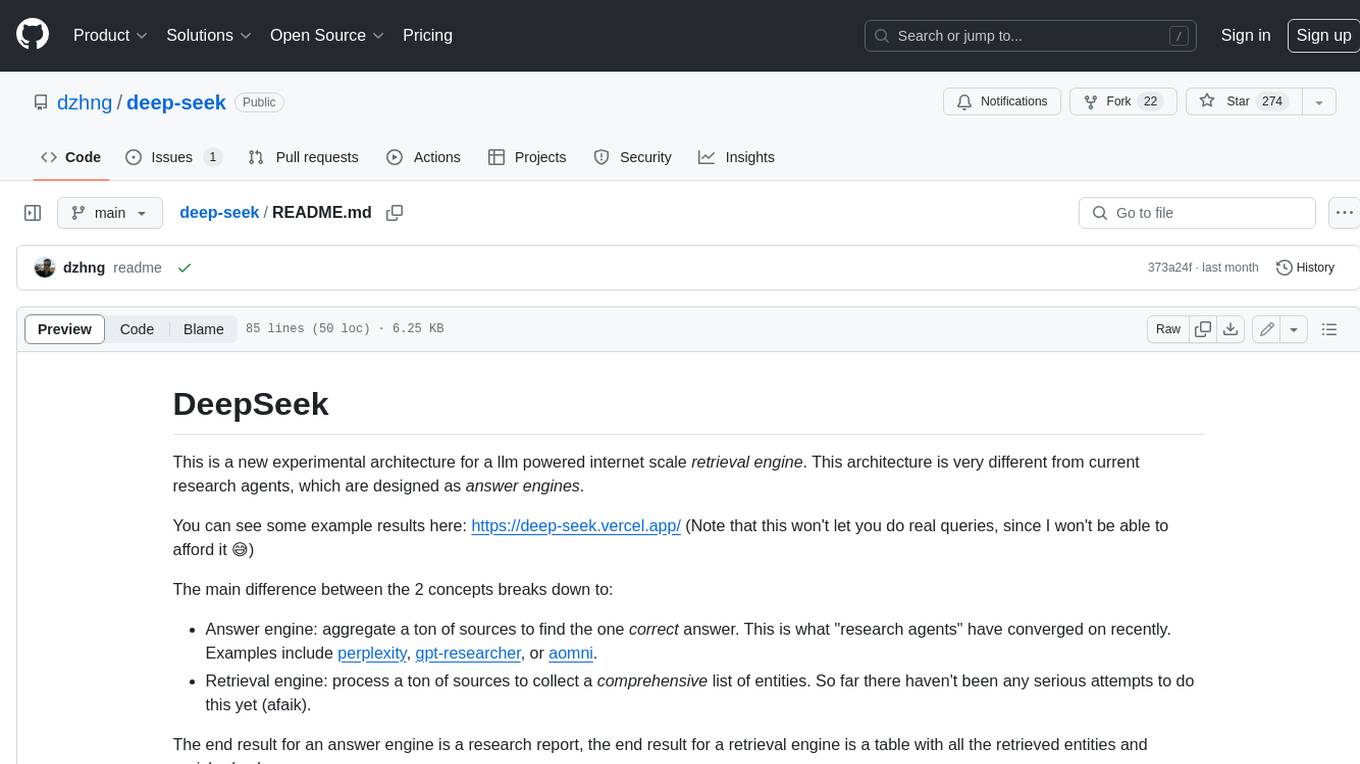
deep-seek
DeepSeek is a new experimental architecture for a large language model (LLM) powered internet-scale retrieval engine. Unlike current research agents designed as answer engines, DeepSeek aims to process a vast amount of sources to collect a comprehensive list of entities and enrich them with additional relevant data. The end result is a table with retrieved entities and enriched columns, providing a comprehensive overview of the topic. DeepSeek utilizes both standard keyword search and neural search to find relevant content, and employs an LLM to extract specific entities and their associated contents. It also includes a smaller answer agent to enrich the retrieved data, ensuring thoroughness. DeepSeek has the potential to revolutionize research and information gathering by providing a comprehensive and structured way to access information from the vastness of the internet.
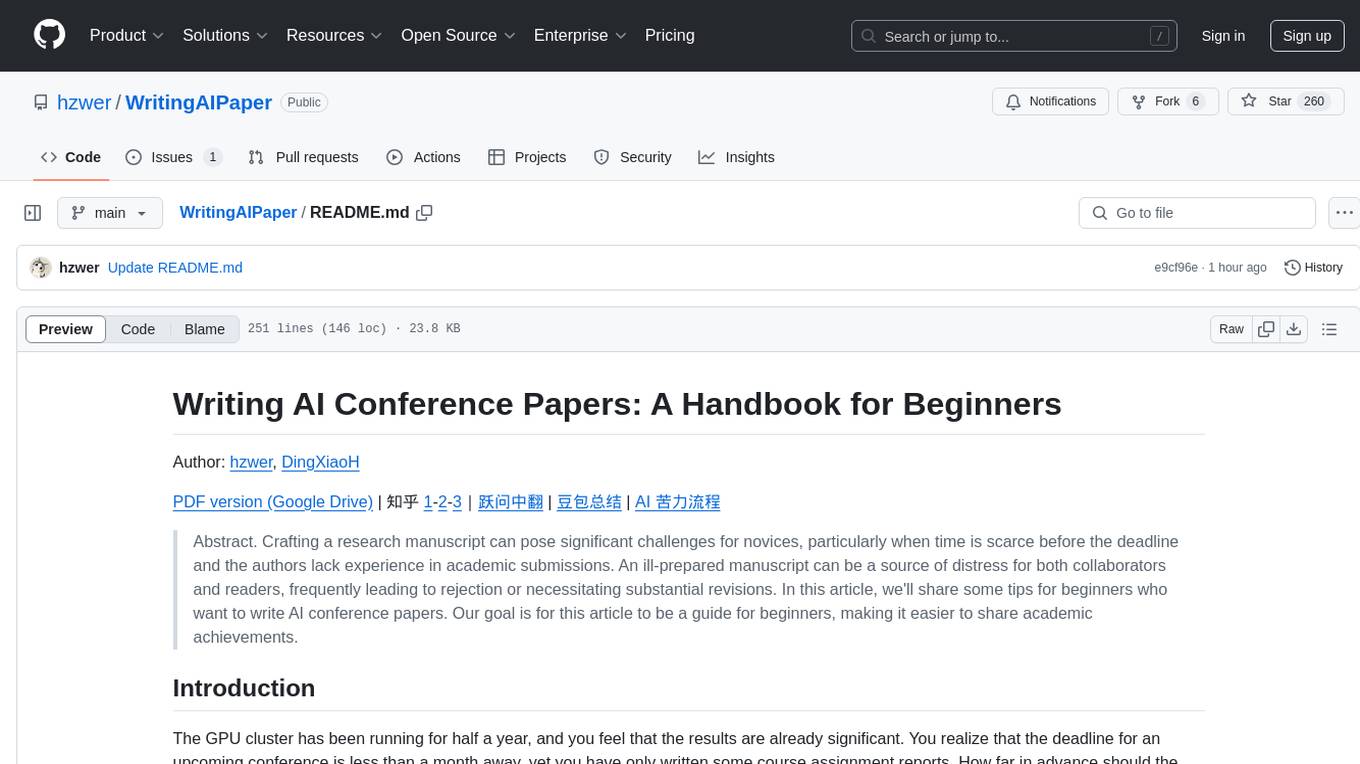
WritingAIPaper
WritingAIPaper is a comprehensive guide for beginners on crafting AI conference papers. It covers topics like paper structure, core ideas, framework construction, result analysis, and introduction writing. The guide aims to help novices navigate the complexities of academic writing and contribute to the field with clarity and confidence. It also provides tips on readability improvement, logical strength, defensibility, confusion time reduction, and information density increase. The appendix includes sections on AI paper production, a checklist for final hours, common negative review comments, and advice on dealing with paper rejection.
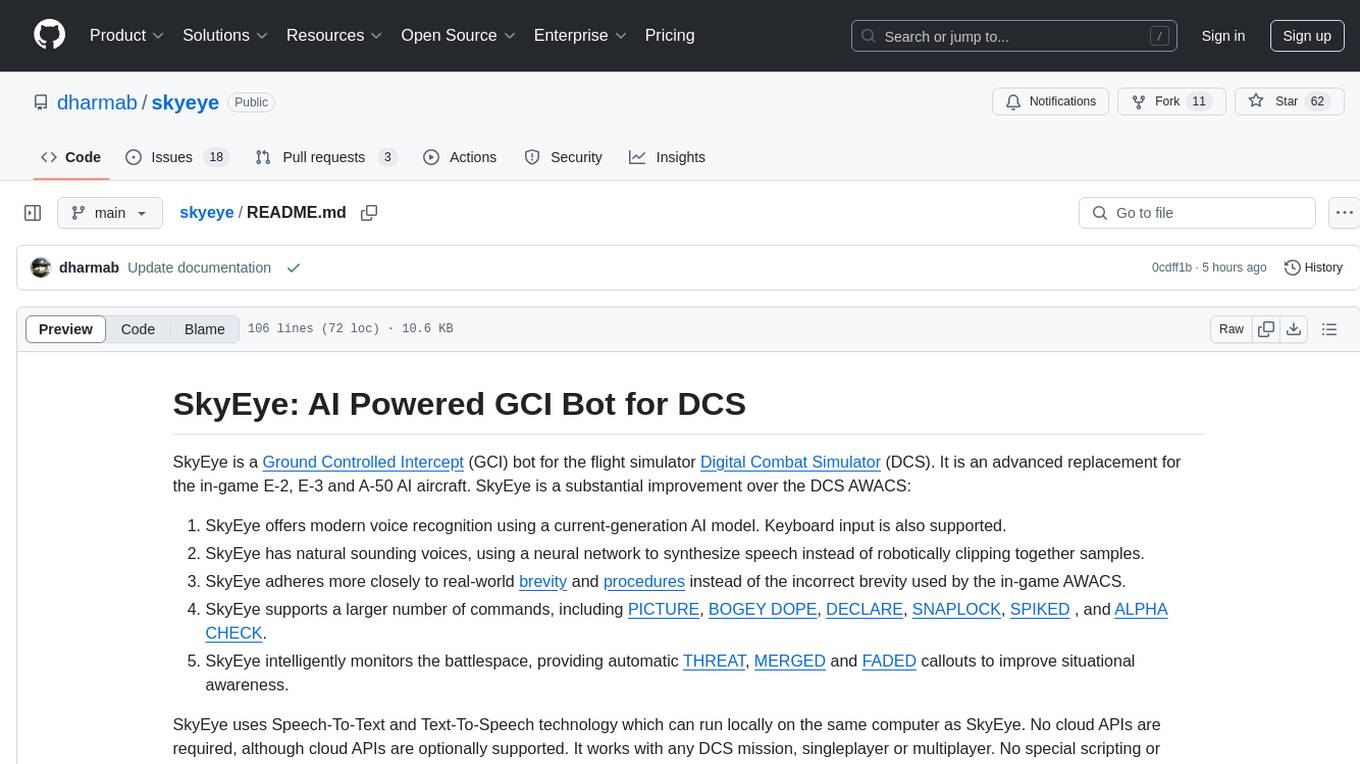
skyeye
SkyEye is an AI-powered Ground Controlled Intercept (GCI) bot designed for the flight simulator Digital Combat Simulator (DCS). It serves as an advanced replacement for the in-game E-2, E-3, and A-50 AI aircraft, offering modern voice recognition, natural-sounding voices, real-world brevity and procedures, a wide range of commands, and intelligent battlespace monitoring. The tool uses Speech-To-Text and Text-To-Speech technology, can run locally or on a cloud server, and is production-ready software used by various DCS communities.
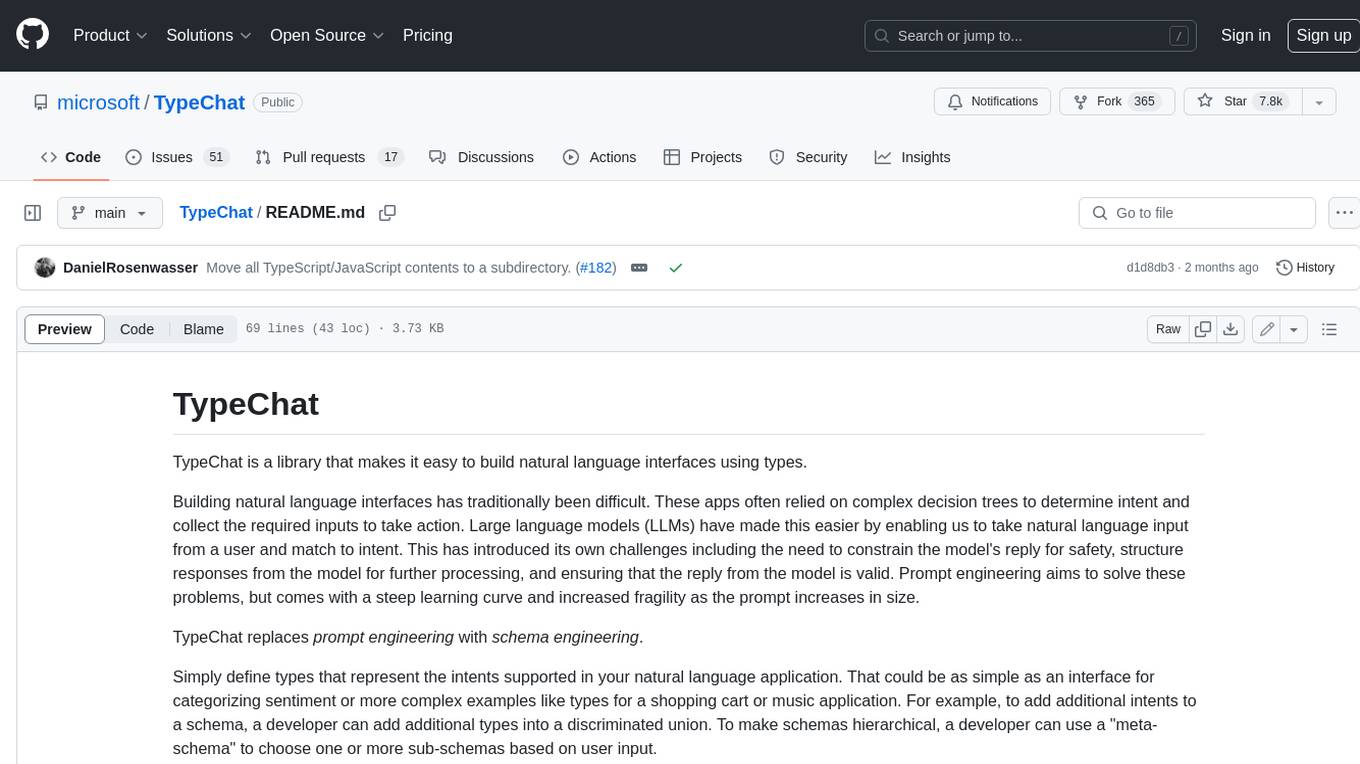
TypeChat
TypeChat is a library that simplifies the creation of natural language interfaces using types. Traditionally, building natural language interfaces has been challenging, often relying on complex decision trees to determine intent and gather necessary inputs for action. Large language models (LLMs) have simplified this process by allowing us to accept natural language input from users and match it to intent. However, this has introduced new challenges, such as the need to constrain the model's response for safety, structure responses from the model for further processing, and ensure the validity of the model's response. Prompt engineering aims to address these issues, but it comes with a steep learning curve and increased fragility as the prompt grows in size.
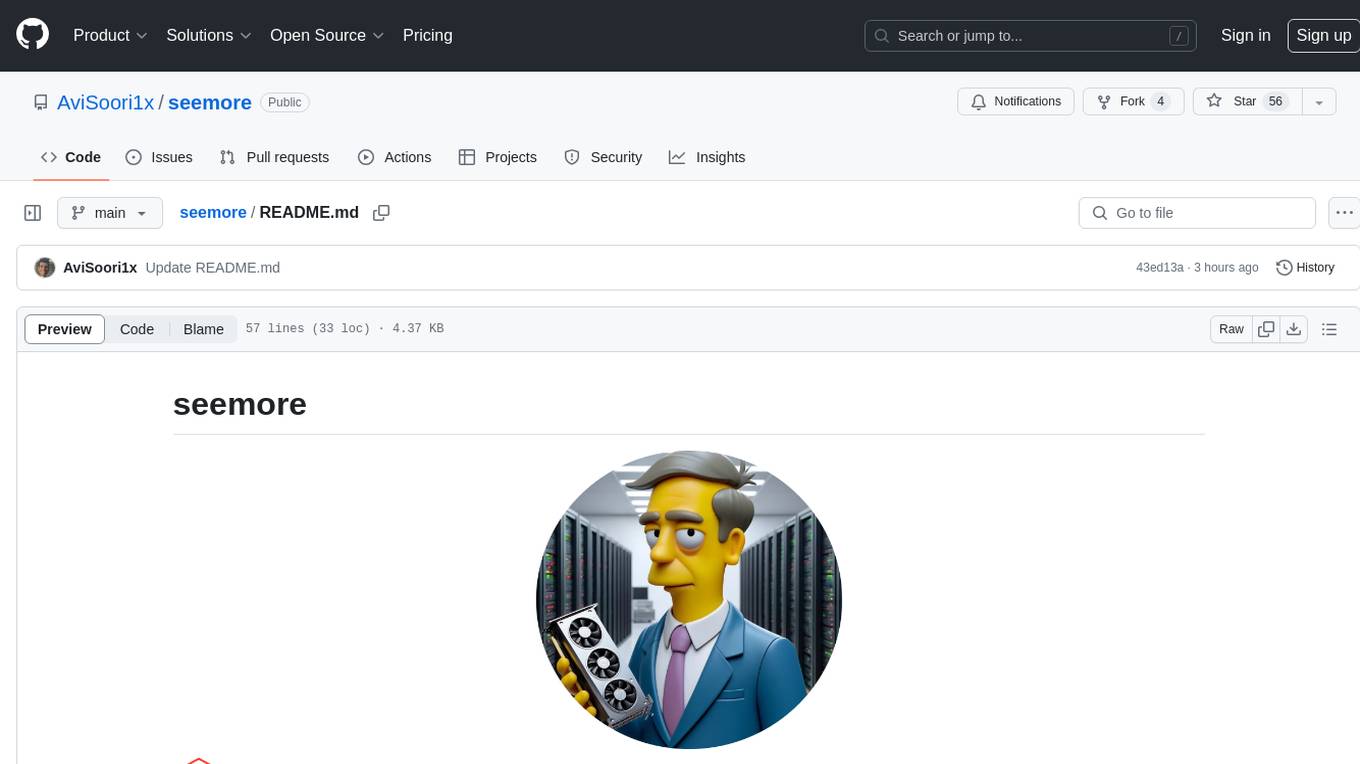
seemore
seemore is a vision language model developed in Pytorch, implementing components like image encoder, vision-language projector, and decoder language model. The model is built from scratch, including attention mechanisms and patch creation. It is designed for readability and hackability, with the intention to be improved upon. The implementation is based on public publications and borrows attention mechanism from makemore by Andrej Kapathy. The code was developed on Databricks using a single A100 for compute, and MLFlow is used for tracking metrics. The tool aims to provide a simplistic version of vision language models like Grok 1.5/GPT-4 Vision, suitable for experimentation and learning.
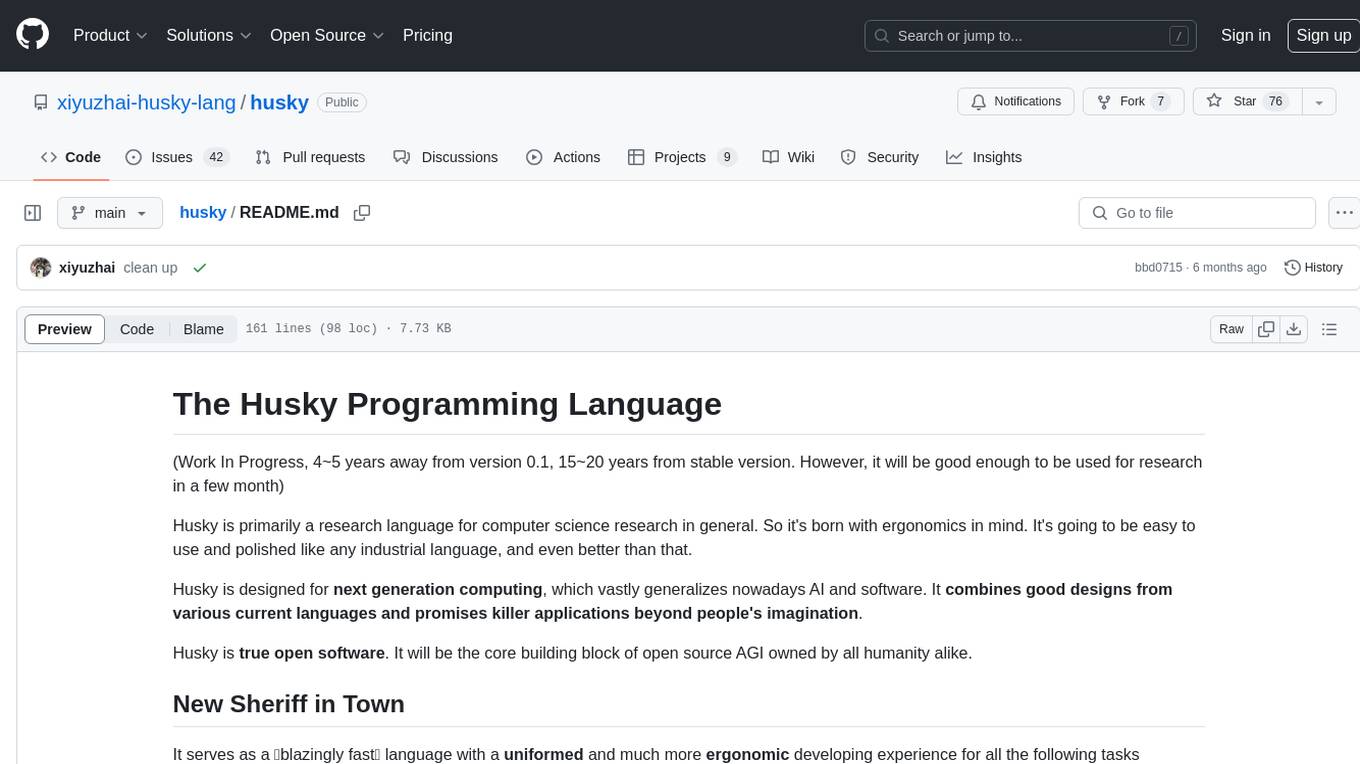
husky
Husky is a research-focused programming language designed for next-generation computing. It aims to provide a powerful and ergonomic development experience for various tasks, including system level programming, web/native frontend development, parser/compiler tasks, game development, formal verification, machine learning, and more. With a strong type system and support for human-in-the-loop programming, Husky enables users to tackle complex tasks such as explainable image classification, natural language processing, and reinforcement learning. The language prioritizes debugging, visualization, and human-computer interaction, offering agile compilation and evaluation, multiparadigm support, and a commitment to a good ecosystem.
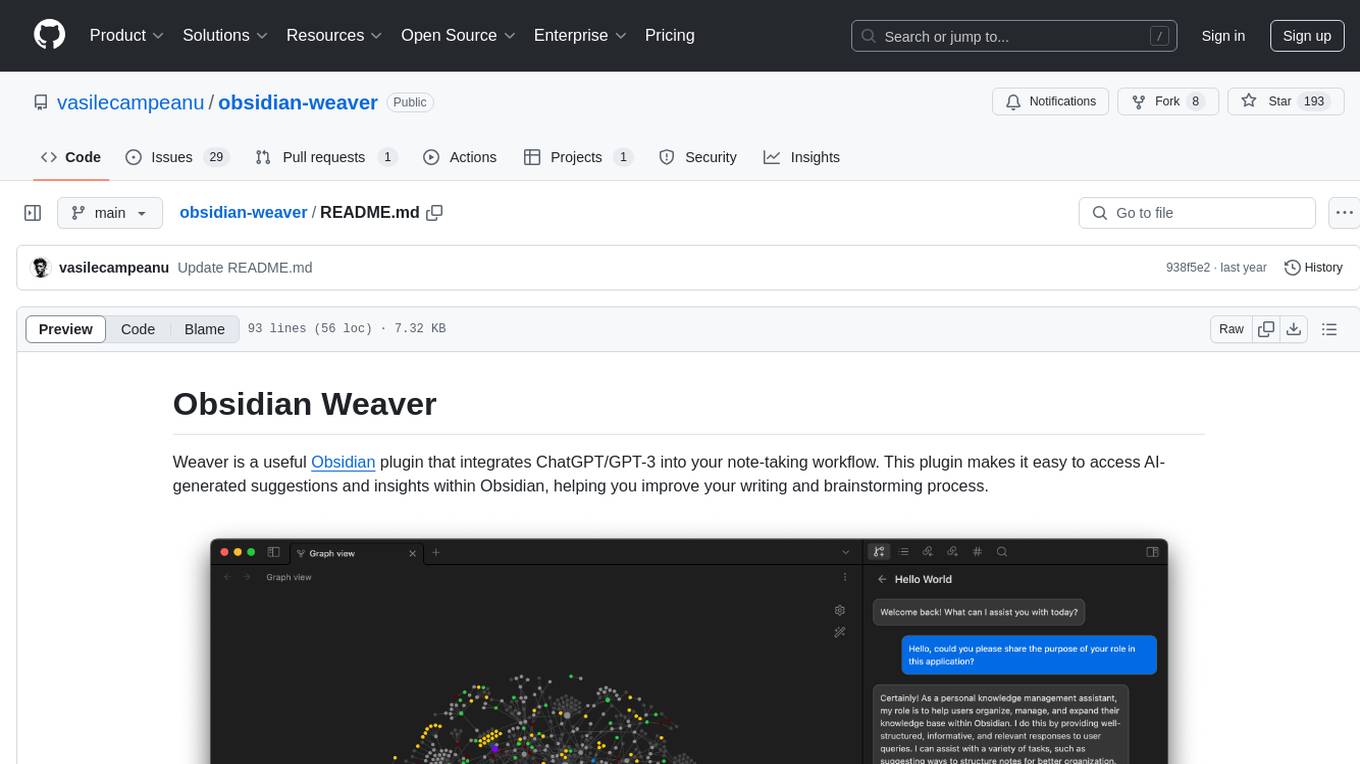
obsidian-weaver
Obsidian Weaver is a plugin that integrates ChatGPT/GPT-3 into the note-taking workflow of Obsidian. It allows users to easily access AI-generated suggestions and insights within Obsidian, enhancing the writing and brainstorming process. The plugin respects Obsidian's philosophy of storing notes locally, ensuring data security and privacy. Weaver offers features like creating new chat sessions with the AI assistant and receiving instant responses, all within the Obsidian environment. It provides a seamless integration with Obsidian's interface, making the writing process efficient and helping users stay focused. The plugin is constantly being improved with new features and updates to enhance the note-taking experience.
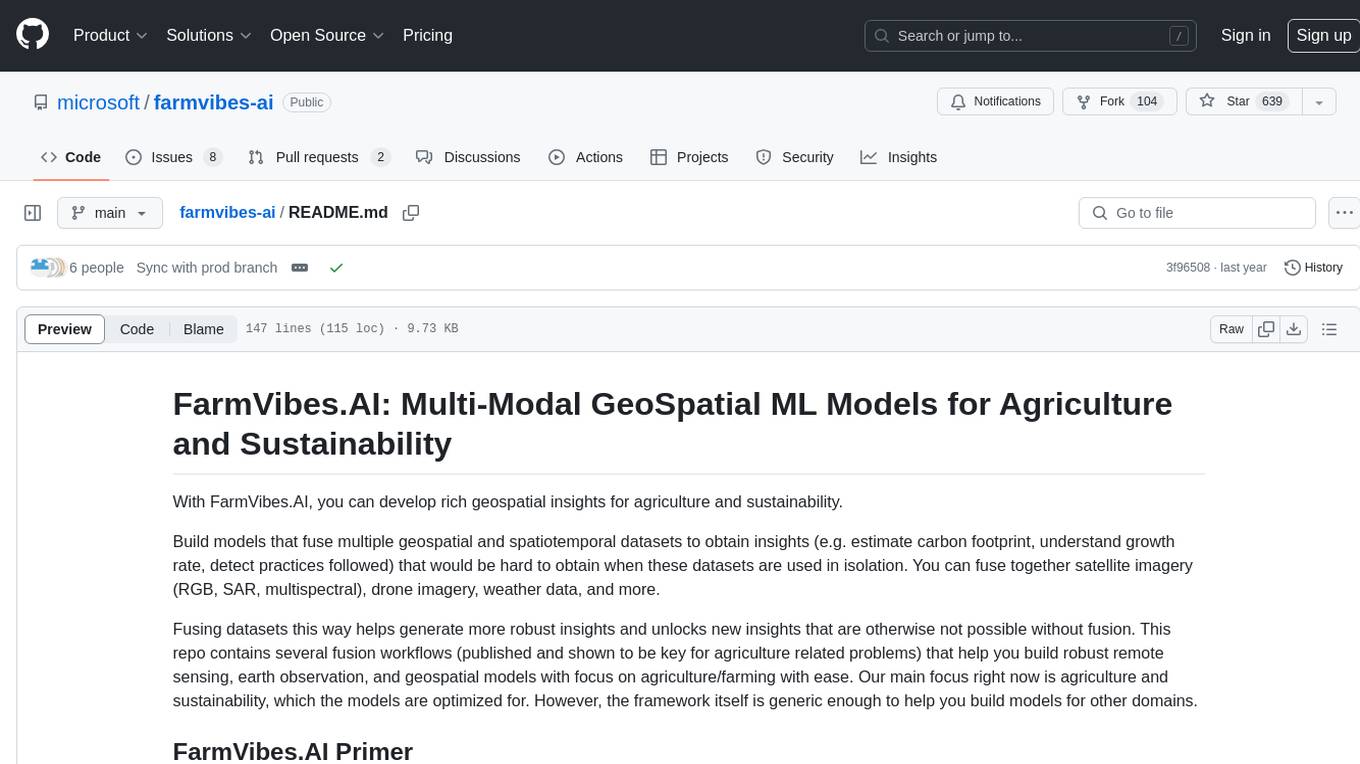
farmvibes-ai
FarmVibes.AI is a repository focused on developing multi-modal geospatial machine learning models for agriculture and sustainability. It enables users to fuse various geospatial and spatiotemporal datasets, such as satellite imagery, drone imagery, and weather data, to generate robust insights for agriculture-related problems. The repository provides fusion workflows, data preparation tools, model training notebooks, and an inference engine to facilitate the creation of geospatial models tailored for agriculture and farming. Users can interact with the tools via a local cluster, REST API, or a Python client, and the repository includes documentation and notebook examples to guide users in utilizing FarmVibes.AI for tasks like harvest date detection, climate impact estimation, micro climate prediction, and crop identification.
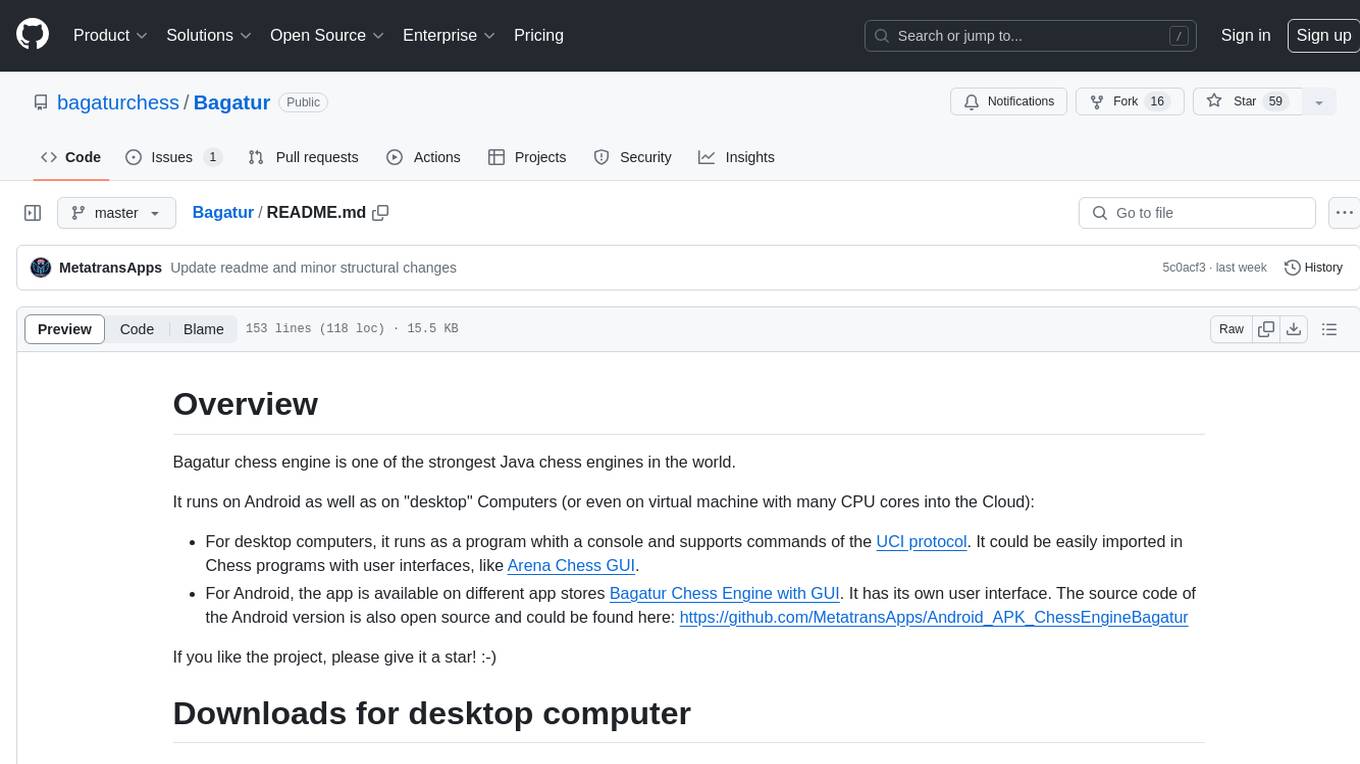
Bagatur
Bagatur chess engine is a powerful Java chess engine that can run on Android devices and desktop computers. It supports the UCI protocol and can be easily integrated into chess programs with user interfaces. The engine is available for download on various platforms and has advanced features like SMP (multicore) support and NNUE evaluation function. Bagatur also includes syzygy endgame tablebases and offers various UCI options for customization. The project started as a personal challenge to create a chess program that could defeat a friend, leading to years of development and improvements.
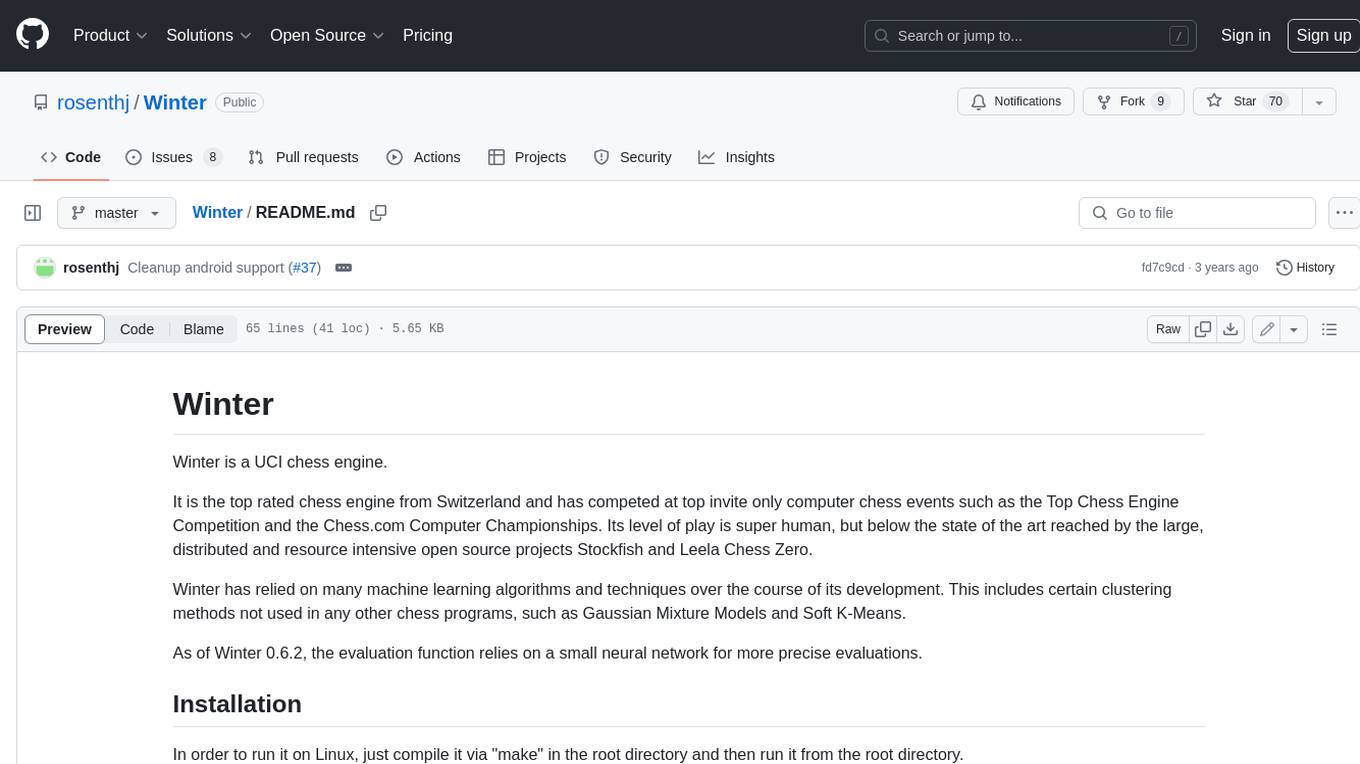
Winter
Winter is a UCI chess engine that has competed at top invite-only computer chess events. It is the top-rated chess engine from Switzerland and has a level of play that is super human but below the state of the art reached by large, distributed, and resource-intensive open-source projects like Stockfish and Leela Chess Zero. Winter has relied on many machine learning algorithms and techniques over the course of its development, including certain clustering methods not used in any other chess programs, such as Gaussian Mixture Models and Soft K-Means. As of Winter 0.6.2, the evaluation function relies on a small neural network for more precise evaluations.
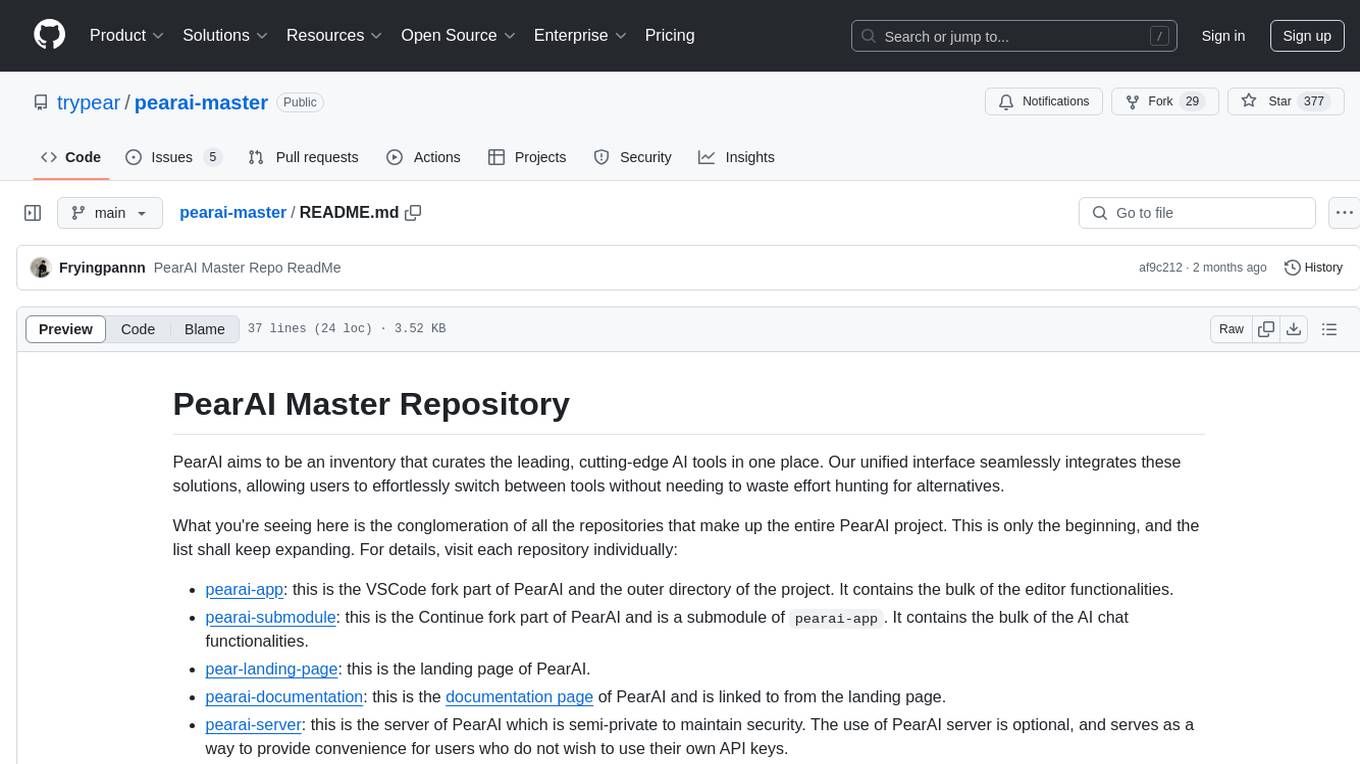
pearai-master
PearAI is an inventory that curates cutting-edge AI tools in one place, offering a unified interface for seamless tool integration. The repository serves as the conglomeration of all PearAI project repositories, including VSCode fork, AI chat functionalities, landing page, documentation, and server. Contributions are welcome through quests and issue tackling, with the project stack including TypeScript/Electron.js, Next.js/React, Python FastAPI, and Axiom for logging/telemetry.
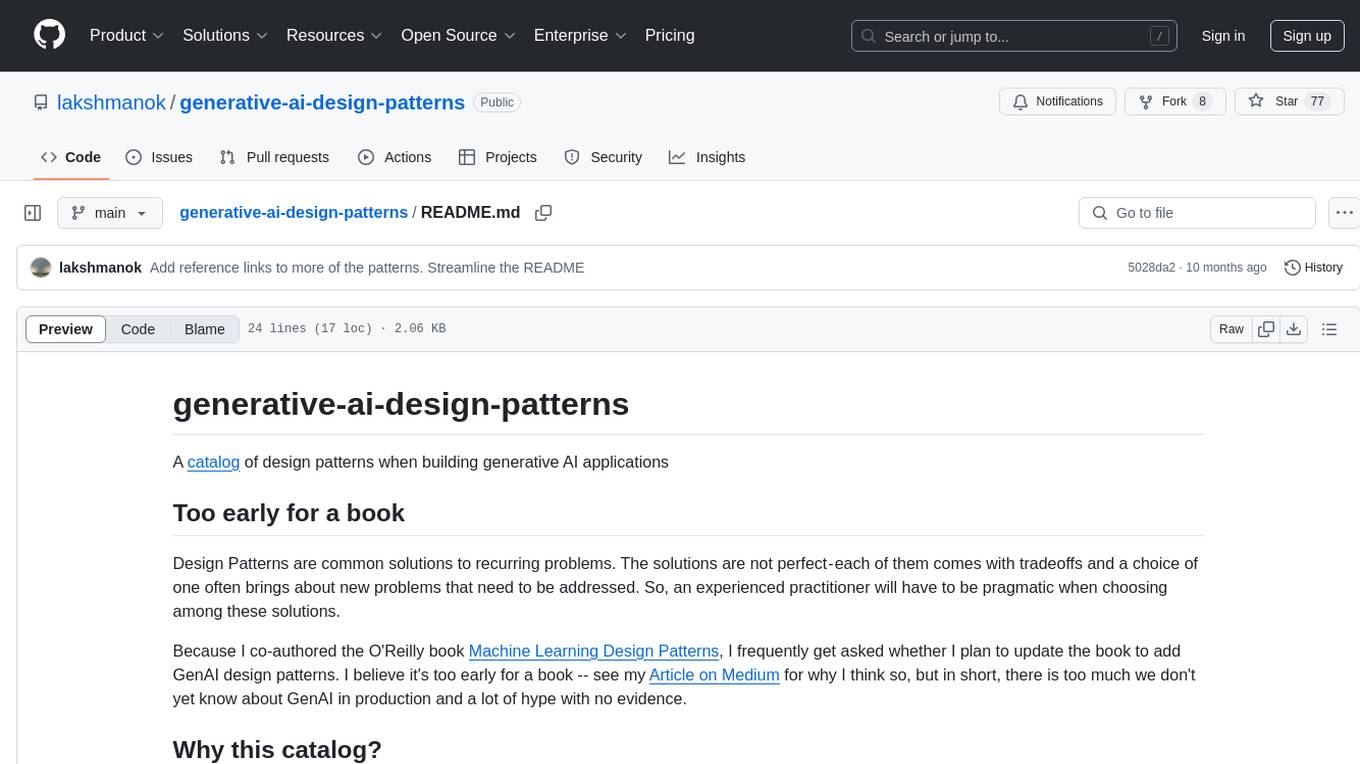
generative-ai-design-patterns
A catalog of design patterns for building generative AI applications, capturing current best practices in the field. The repository serves as a living catalog on GitHub to help practitioners navigate through the noise and identify areas for improvement. It is too early for a book due to the evolving nature of generative AI in production and the lack of concrete evidence to support certain claims.
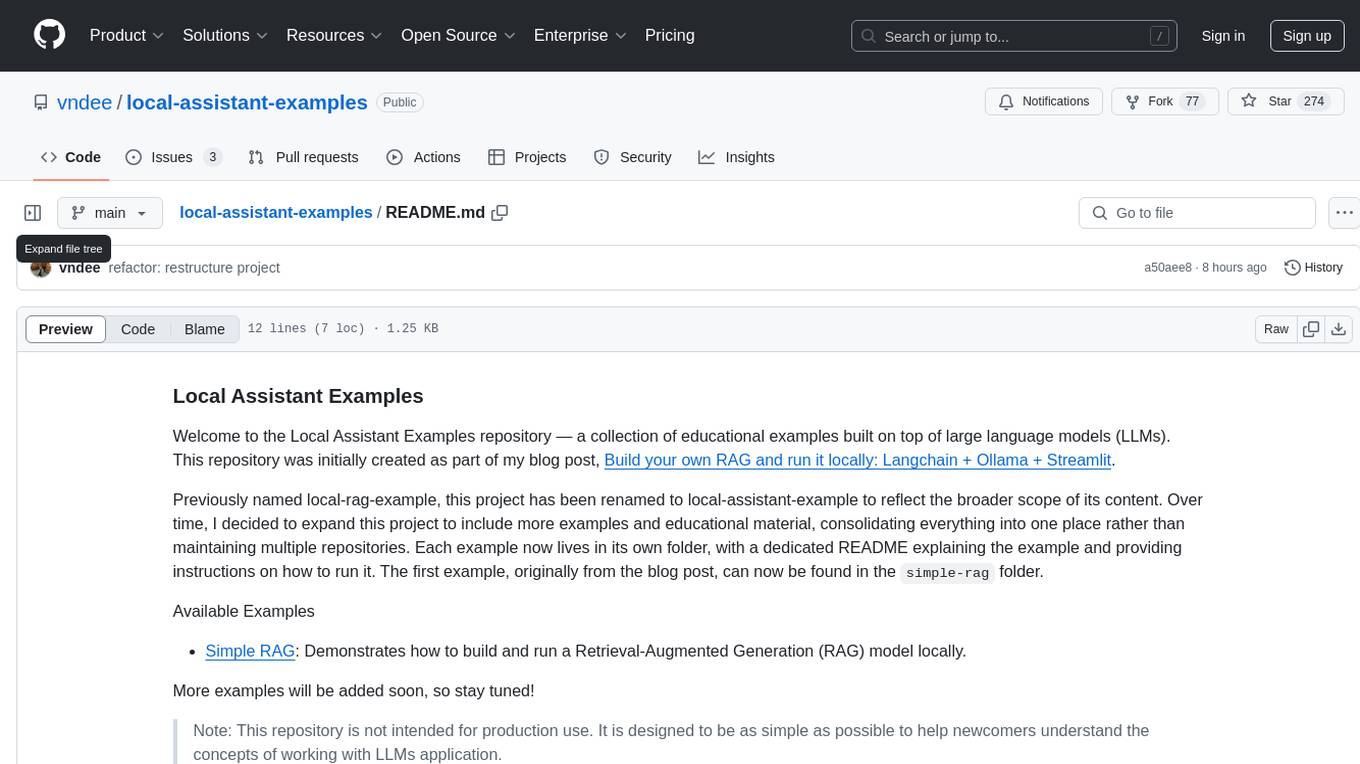
local-assistant-examples
The Local Assistant Examples repository is a collection of educational examples showcasing the use of large language models (LLMs). It was initially created for a blog post on building a RAG model locally, and has since expanded to include more examples and educational material. Each example is housed in its own folder with a dedicated README providing instructions on how to run it. The repository is designed to be simple and educational, not for production use.
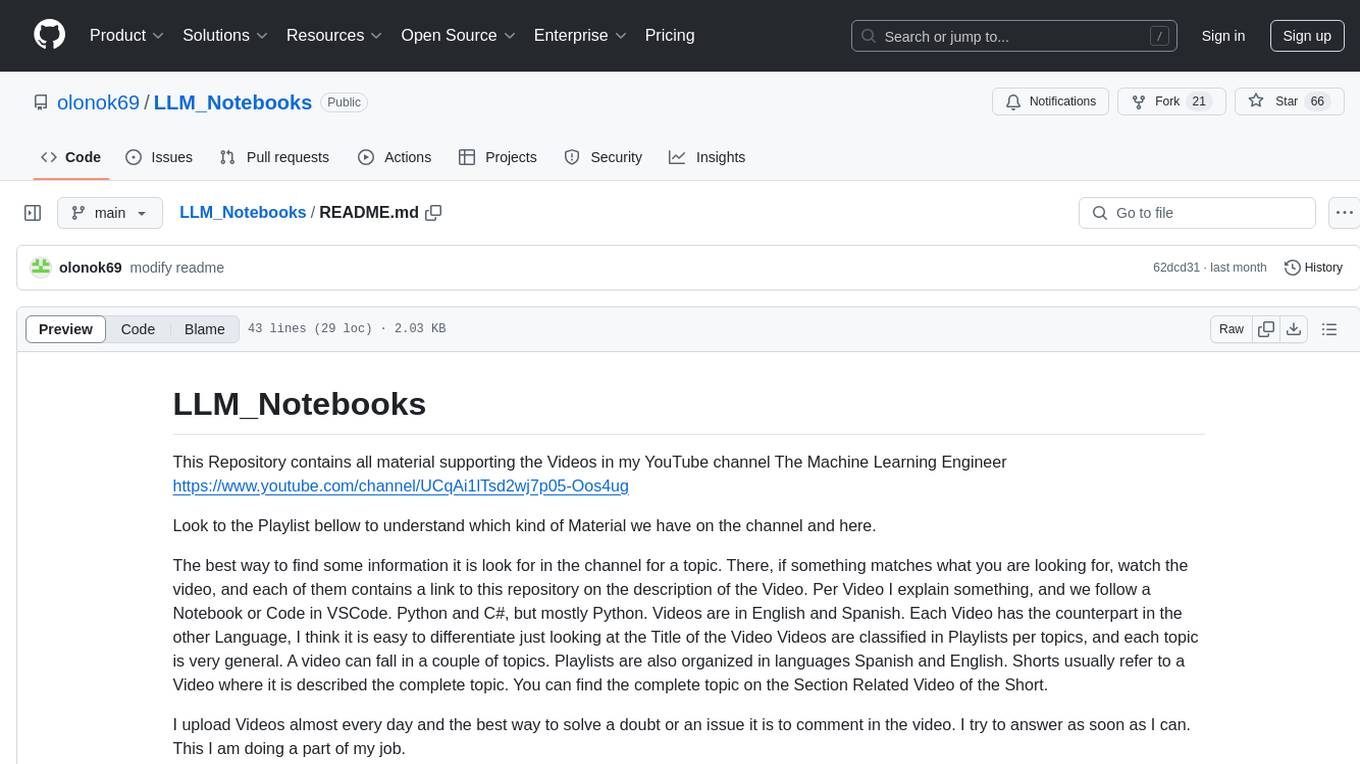
LLM_Notebooks
LLM_Notebooks is a repository supporting The Machine Learning Engineer YouTube channel. It contains materials related to various topics such as Generative AI, MLOps, ML projects, Azure Projects, Google VertexAi, ML Tricks, and more. The repository includes notebooks and code in Python and C#, with a focus on Python. The videos on the channel cover a wide range of topics in English and Spanish, organized into playlists based on general themes. The repository links are provided in the video descriptions for easy access. The creator uploads videos regularly and encourages viewers to subscribe, like, and leave constructive comments. The repository serves as a valuable resource for learning and exploring machine learning concepts and tools.
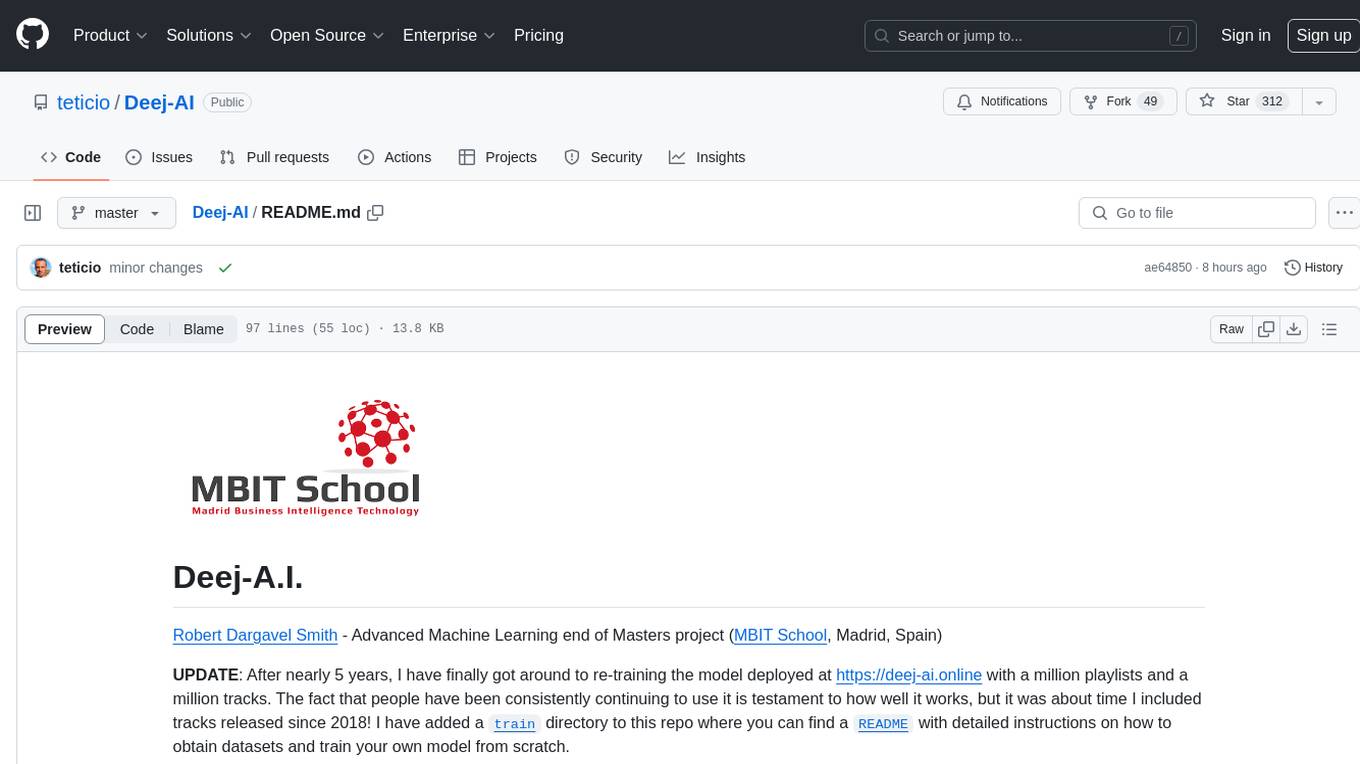
Deej-AI
Deej-A.I. is an advanced machine learning project that aims to revolutionize music recommendation systems by using artificial intelligence to analyze and recommend songs based on their content and characteristics. The project involves scraping playlists from Spotify, creating embeddings of songs, training neural networks to analyze spectrograms, and generating recommendations based on similarities in music features. Deej-A.I. offers a unique approach to music curation, focusing on the 'what' rather than the 'how' of DJing, and providing users with personalized and creative music suggestions.
For similar tasks

commonplace-bot
Commonplace Bot is a modern representation of the commonplace book, leveraging modern technological advancements in computation, data storage, machine learning, and networking. It aims to capture, engage, and share knowledge by providing a platform for users to collect ideas, quotes, and information, organize them efficiently, engage with the data through various strategies and triggers, and transform the data into new mediums for sharing. The tool utilizes embeddings and cached transformations for efficient data storage and retrieval, flips traditional engagement rules by engaging with the user, and enables users to alchemize raw data into new forms like art prompts. Commonplace Bot offers a unique approach to knowledge management and creative expression.
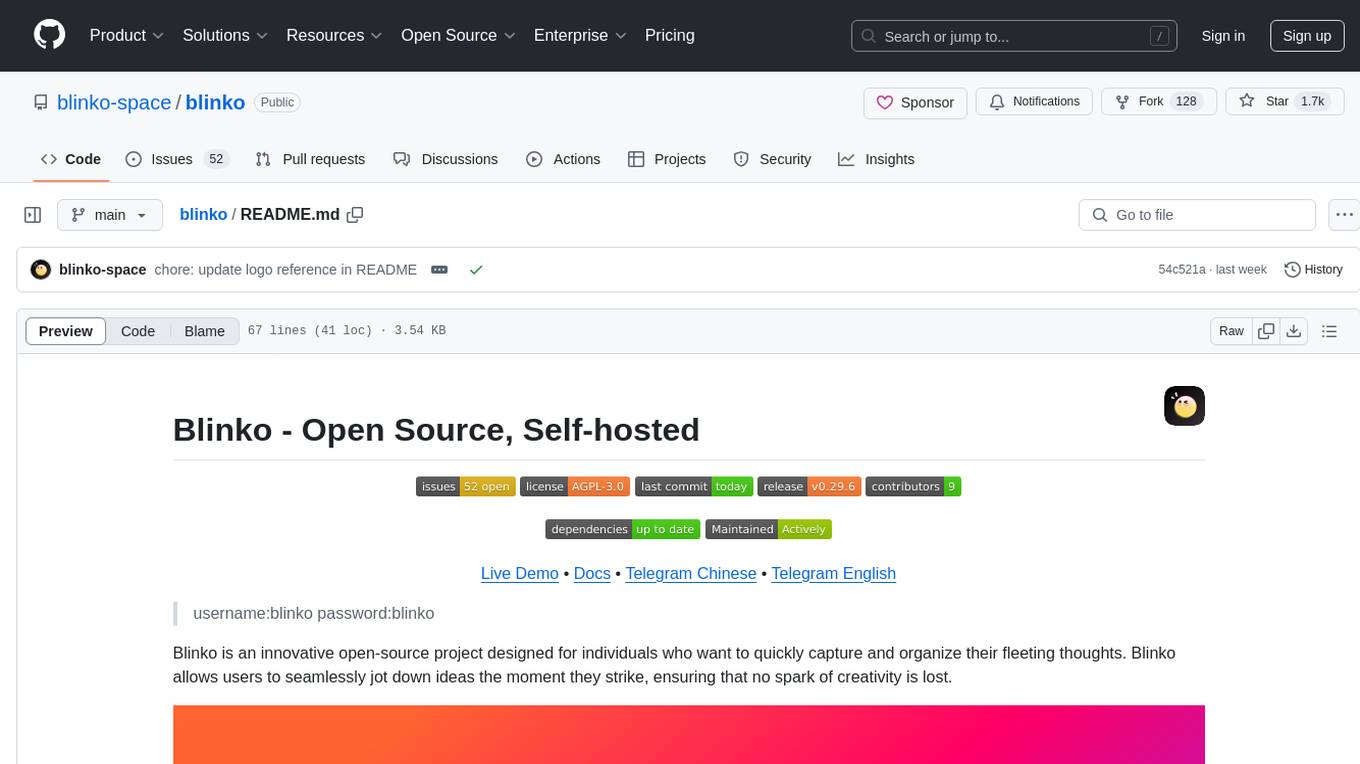
blinko
Blinko is an innovative open-source project designed for individuals who want to quickly capture and organize their fleeting thoughts. It allows users to seamlessly jot down ideas the moment they strike, ensuring that no spark of creativity is lost. With advanced AI-powered note retrieval, data ownership, efficient and fast capturing, lightweight architecture, and open collaboration, Blinko offers a comprehensive solution for managing and accessing notes.
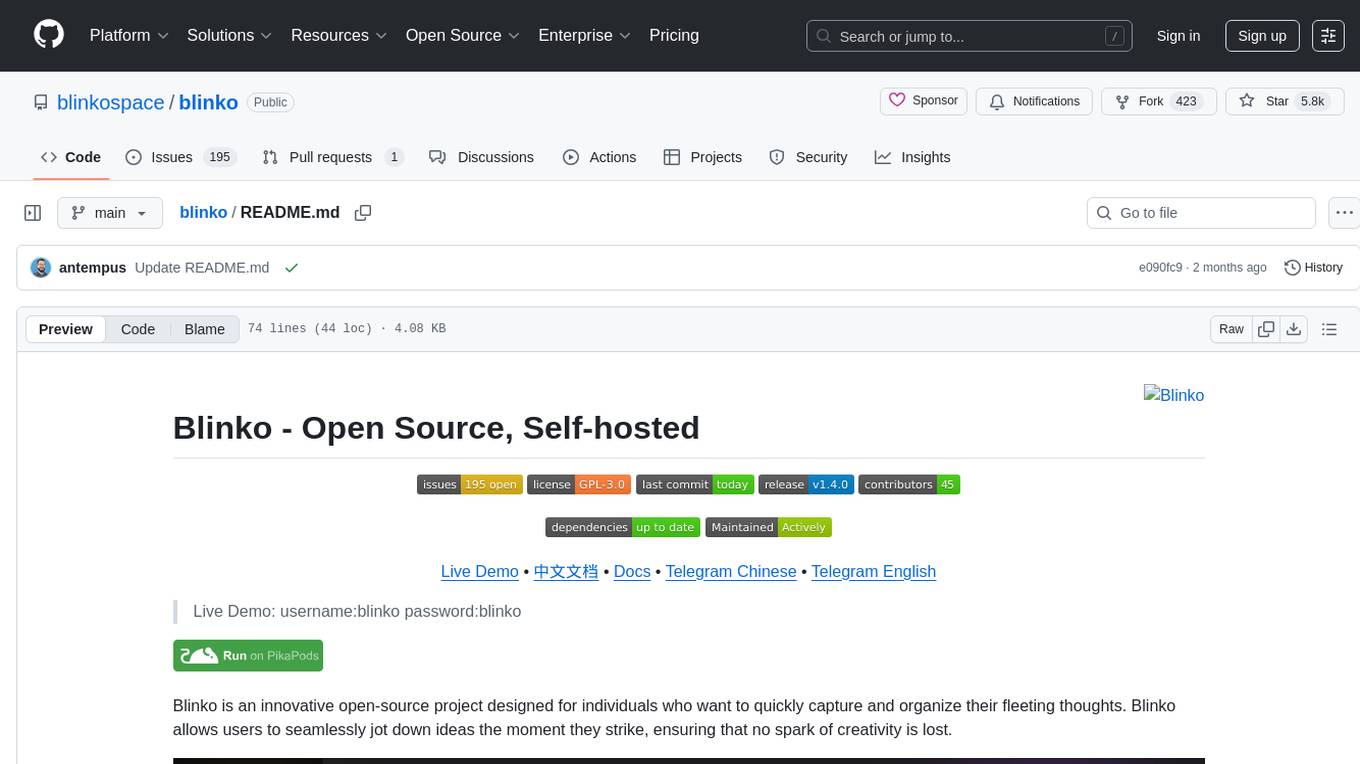
blinko
Blinko is an innovative open-source project designed for individuals who want to quickly capture and organize their fleeting thoughts. It allows users to seamlessly jot down ideas, ensuring no spark of creativity is lost. With AI-enhanced note retrieval, data ownership, efficient and fast note-taking, lightweight architecture, and open collaboration, Blinko offers a robust platform for managing and accessing notes effortlessly.
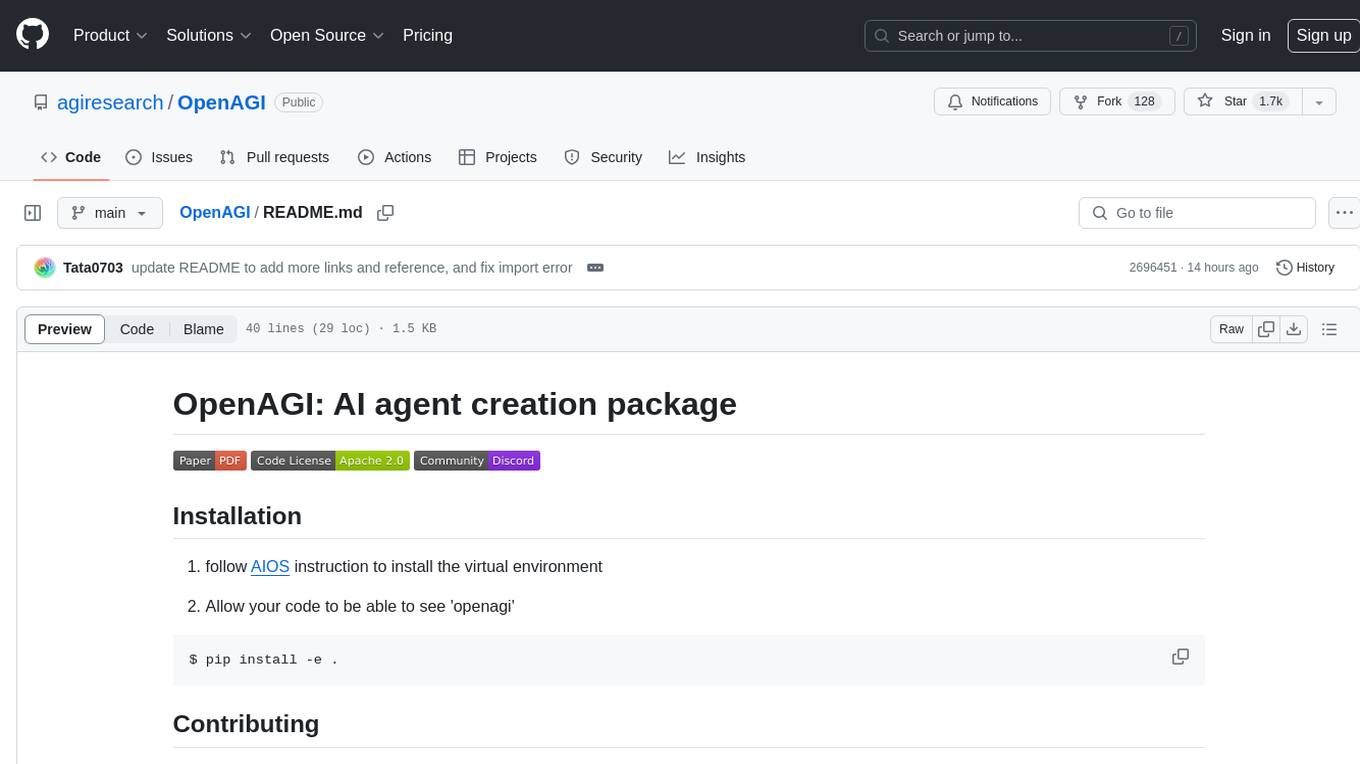
OpenAGI
OpenAGI is an AI agent creation package designed for researchers and developers to create intelligent agents using advanced machine learning techniques. The package provides tools and resources for building and training AI models, enabling users to develop sophisticated AI applications. With a focus on collaboration and community engagement, OpenAGI aims to facilitate the integration of AI technologies into various domains, fostering innovation and knowledge sharing among experts and enthusiasts.
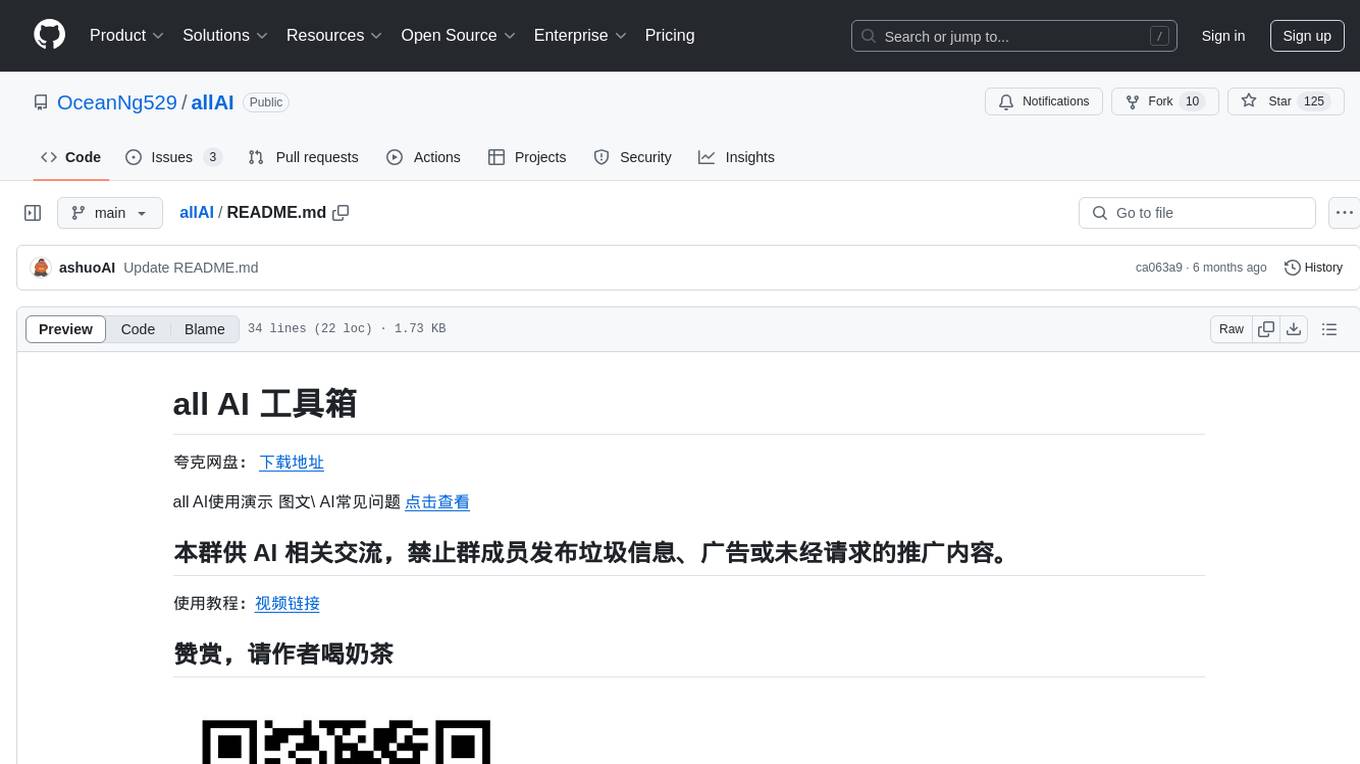
allAI
allAI is a toolbox for AI-related discussions and resources. It provides a platform for sharing knowledge, tutorials, and addressing common AI-related queries. The repository aims to foster a community for AI enthusiasts to engage in meaningful conversations and collaborations. Users can access Quark Cloud for downloads and instructional videos. Additionally, the repository encourages contributions and prohibits the dissemination of spam, advertisements, or unsolicited promotions. The project is supported by Pinokio and offers users the freedom to utilize, modify, and distribute the software within the specified conditions.
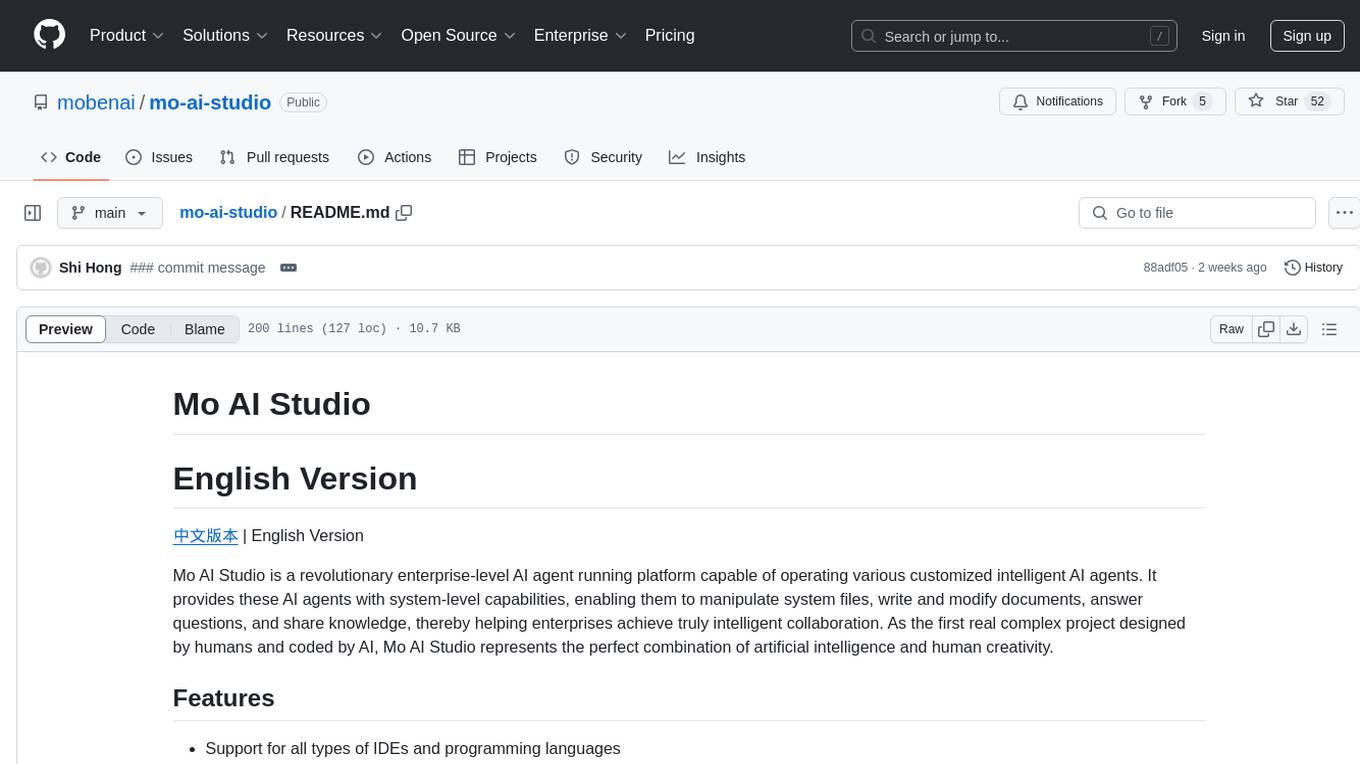
mo-ai-studio
Mo AI Studio is an enterprise-level AI agent running platform that enables the operation of customized intelligent AI agents with system-level capabilities. It supports various IDEs and programming languages, allows modification of multiple files with reasoning, cross-project context modifications, customizable agents, system-level file operations, document writing, question answering, knowledge sharing, and flexible output processors. The platform also offers various setters and a custom component publishing feature. Mo AI Studio is a fusion of artificial intelligence and human creativity, designed to bring unprecedented efficiency and innovation to enterprises.
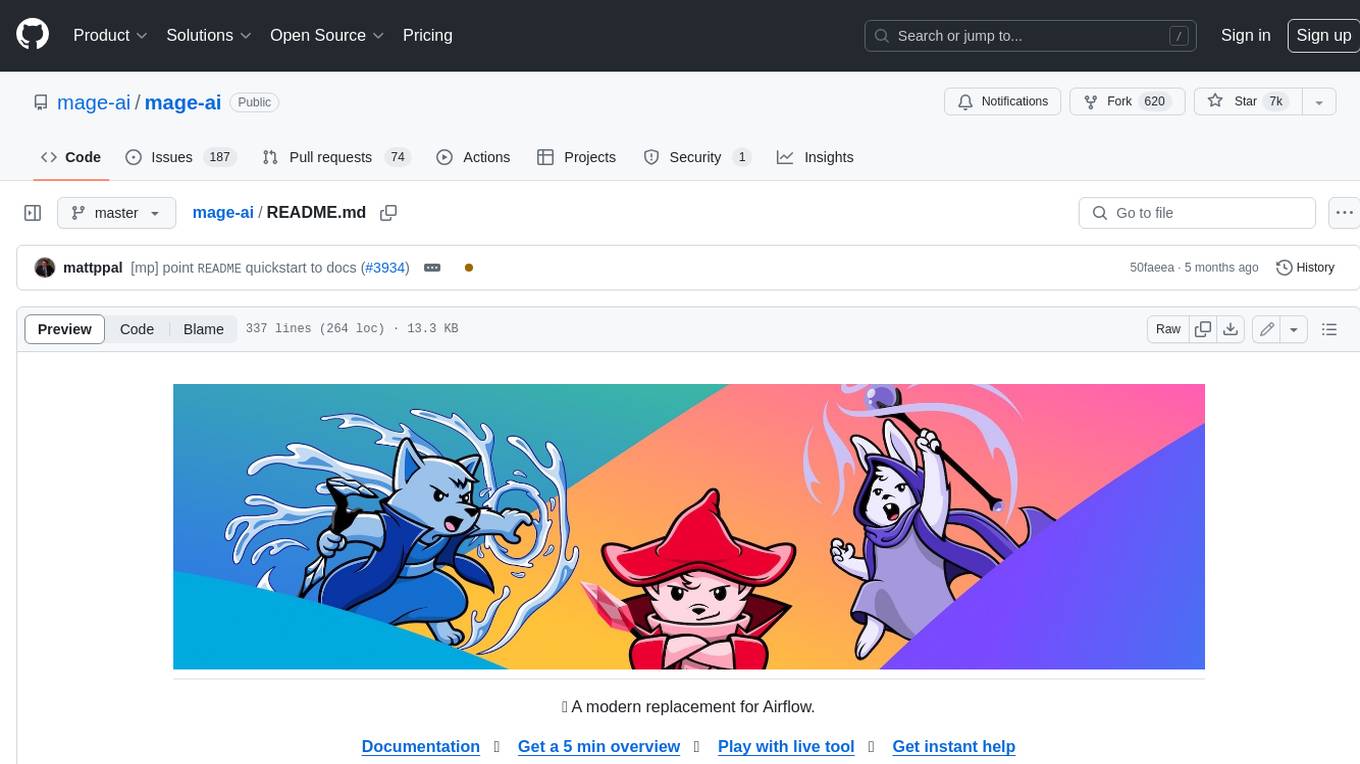
mage-ai
Mage is an open-source data pipeline tool for transforming and integrating data. It offers an easy developer experience, engineering best practices built-in, and data as a first-class citizen. Mage makes it easy to build, preview, and launch data pipelines, and provides observability and scaling capabilities. It supports data integrations, streaming pipelines, and dbt integration.
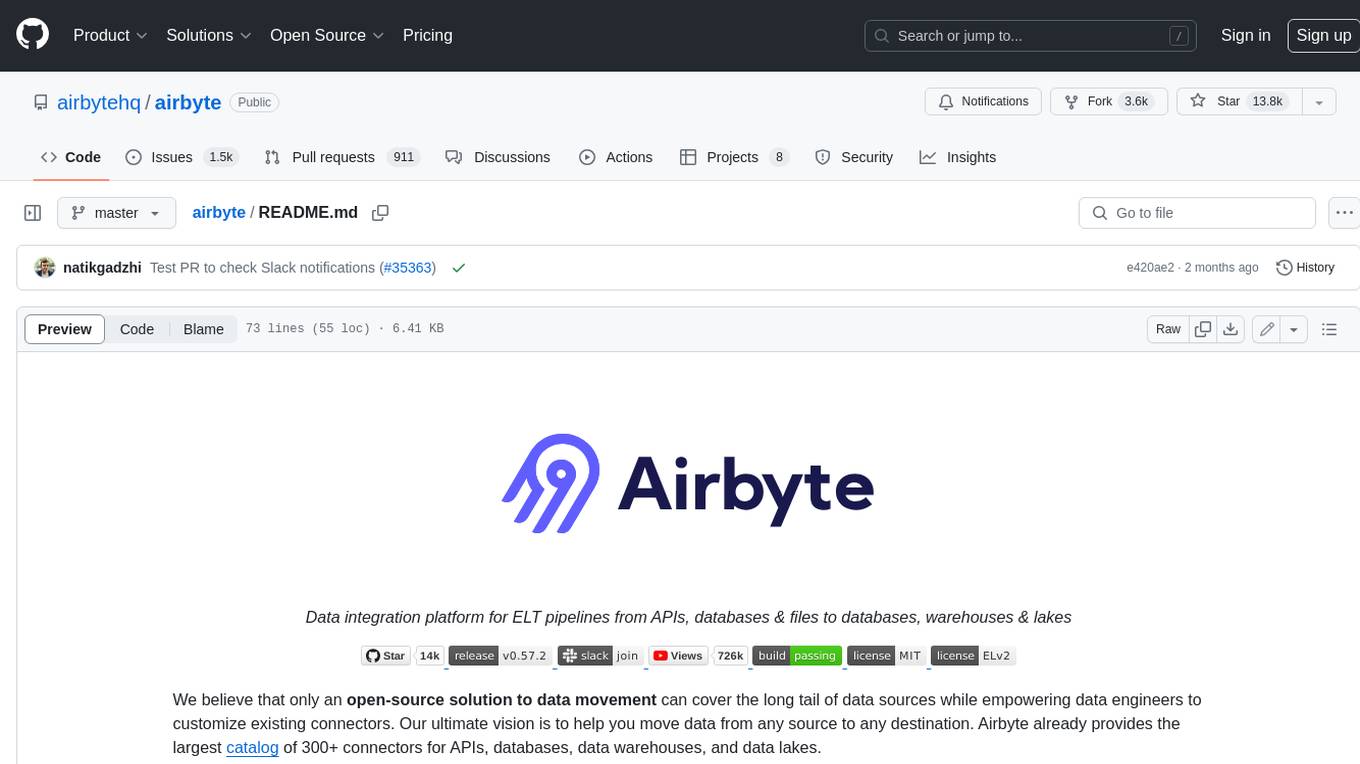
airbyte
Airbyte is an open-source data integration platform that makes it easy to move data from any source to any destination. With Airbyte, you can build and manage data pipelines without writing any code. Airbyte provides a library of pre-built connectors that make it easy to connect to popular data sources and destinations. You can also create your own connectors using Airbyte's no-code Connector Builder or low-code CDK. Airbyte is used by data engineers and analysts at companies of all sizes to build and manage their data pipelines.
For similar jobs

LLMStack
LLMStack is a no-code platform for building generative AI agents, workflows, and chatbots. It allows users to connect their own data, internal tools, and GPT-powered models without any coding experience. LLMStack can be deployed to the cloud or on-premise and can be accessed via HTTP API or triggered from Slack or Discord.
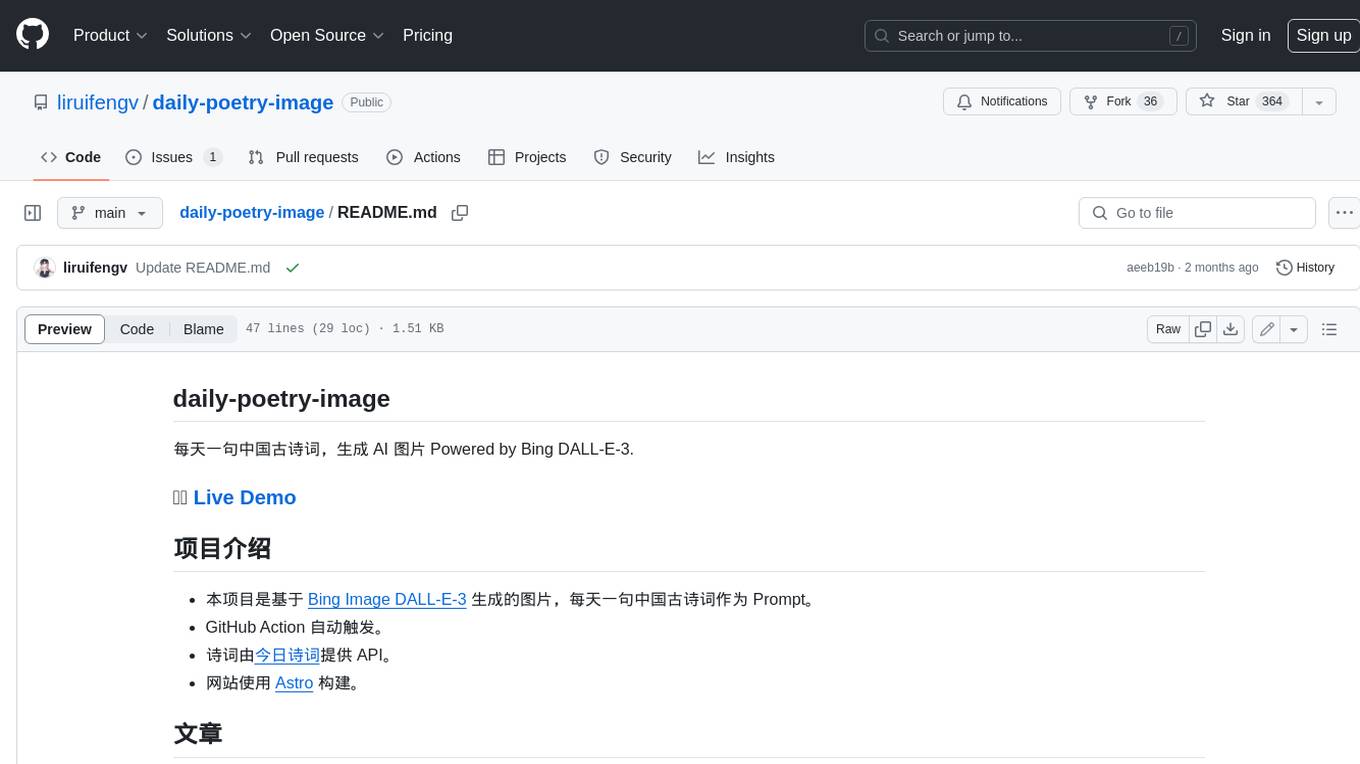
daily-poetry-image
Daily Chinese ancient poetry and AI-generated images powered by Bing DALL-E-3. GitHub Action triggers the process automatically. Poetry is provided by Today's Poem API. The website is built with Astro.
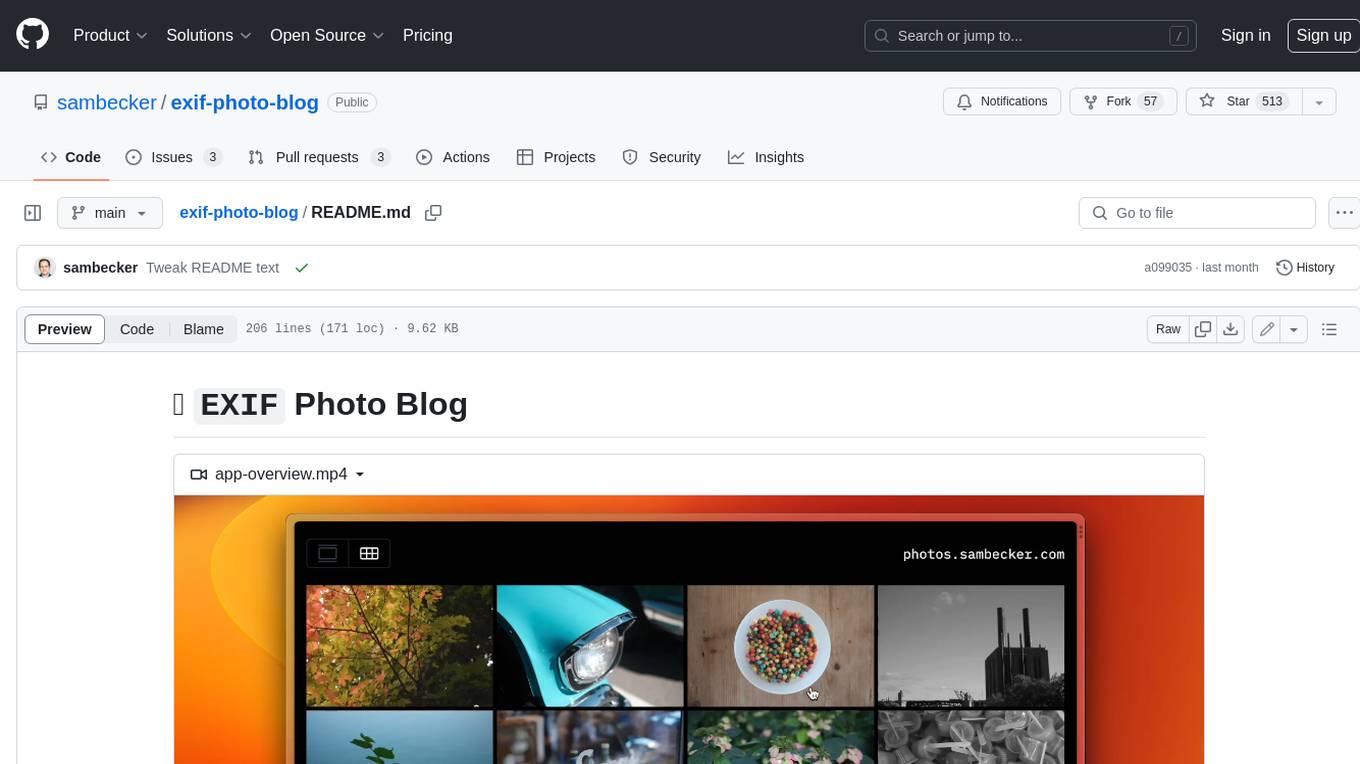
exif-photo-blog
EXIF Photo Blog is a full-stack photo blog application built with Next.js, Vercel, and Postgres. It features built-in authentication, photo upload with EXIF extraction, photo organization by tag, infinite scroll, light/dark mode, automatic OG image generation, a CMD-K menu with photo search, experimental support for AI-generated descriptions, and support for Fujifilm simulations. The application is easy to deploy to Vercel with just a few clicks and can be customized with a variety of environment variables.
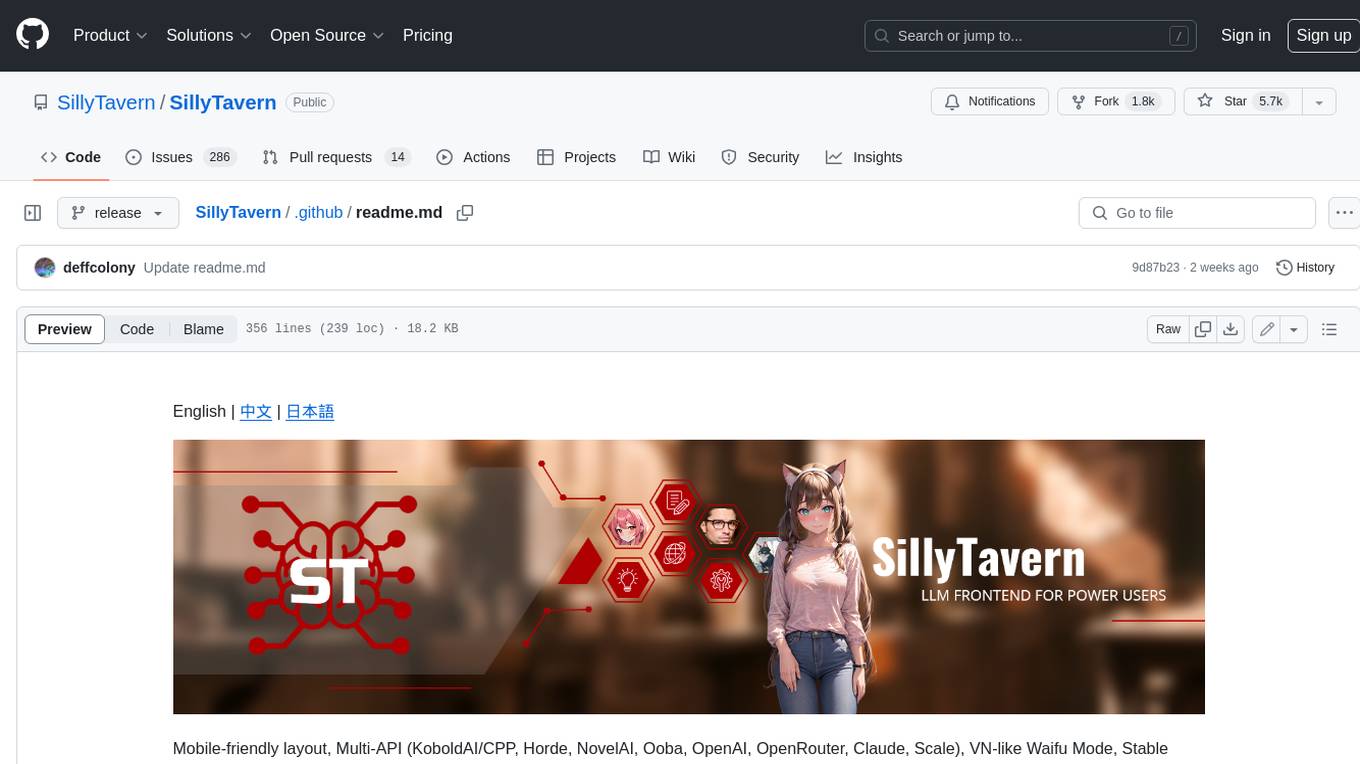
SillyTavern
SillyTavern is a user interface you can install on your computer (and Android phones) that allows you to interact with text generation AIs and chat/roleplay with characters you or the community create. SillyTavern is a fork of TavernAI 1.2.8 which is under more active development and has added many major features. At this point, they can be thought of as completely independent programs.
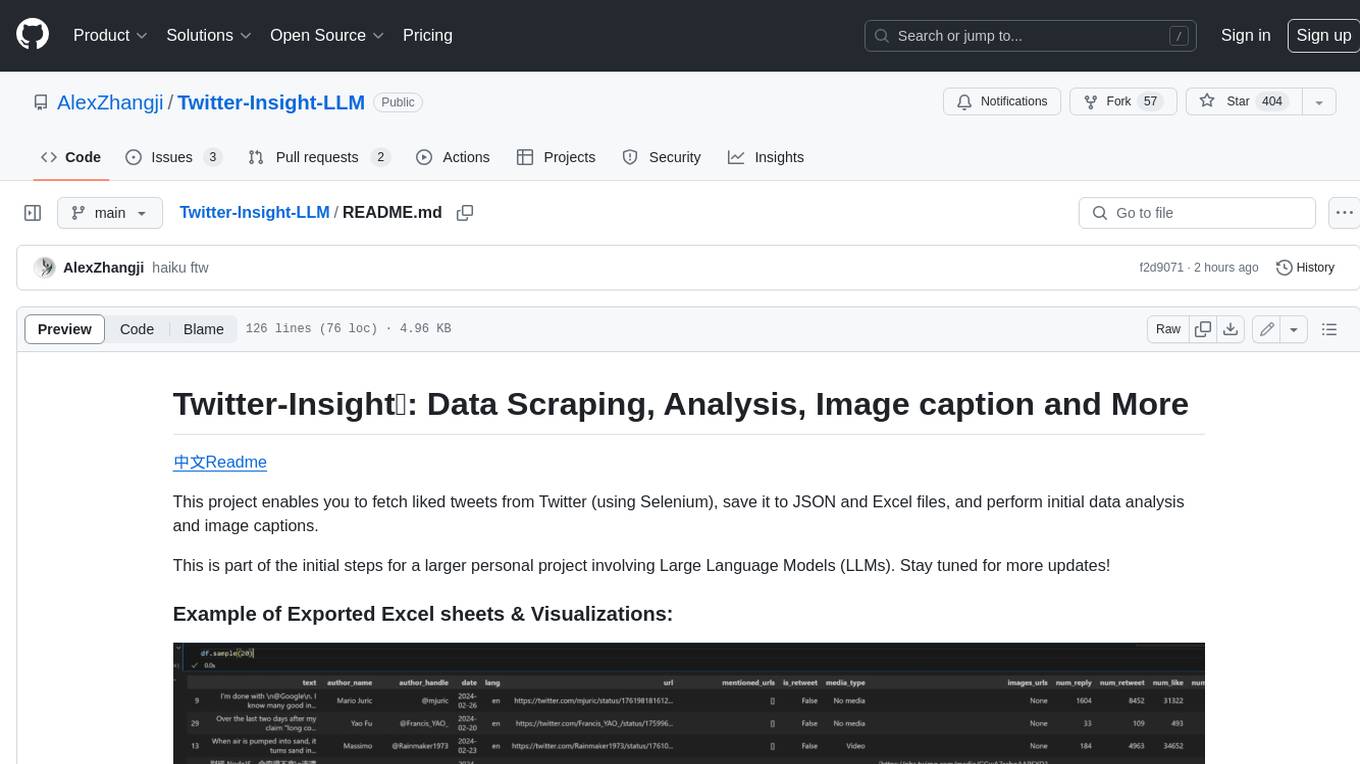
Twitter-Insight-LLM
This project enables you to fetch liked tweets from Twitter (using Selenium), save it to JSON and Excel files, and perform initial data analysis and image captions. This is part of the initial steps for a larger personal project involving Large Language Models (LLMs).
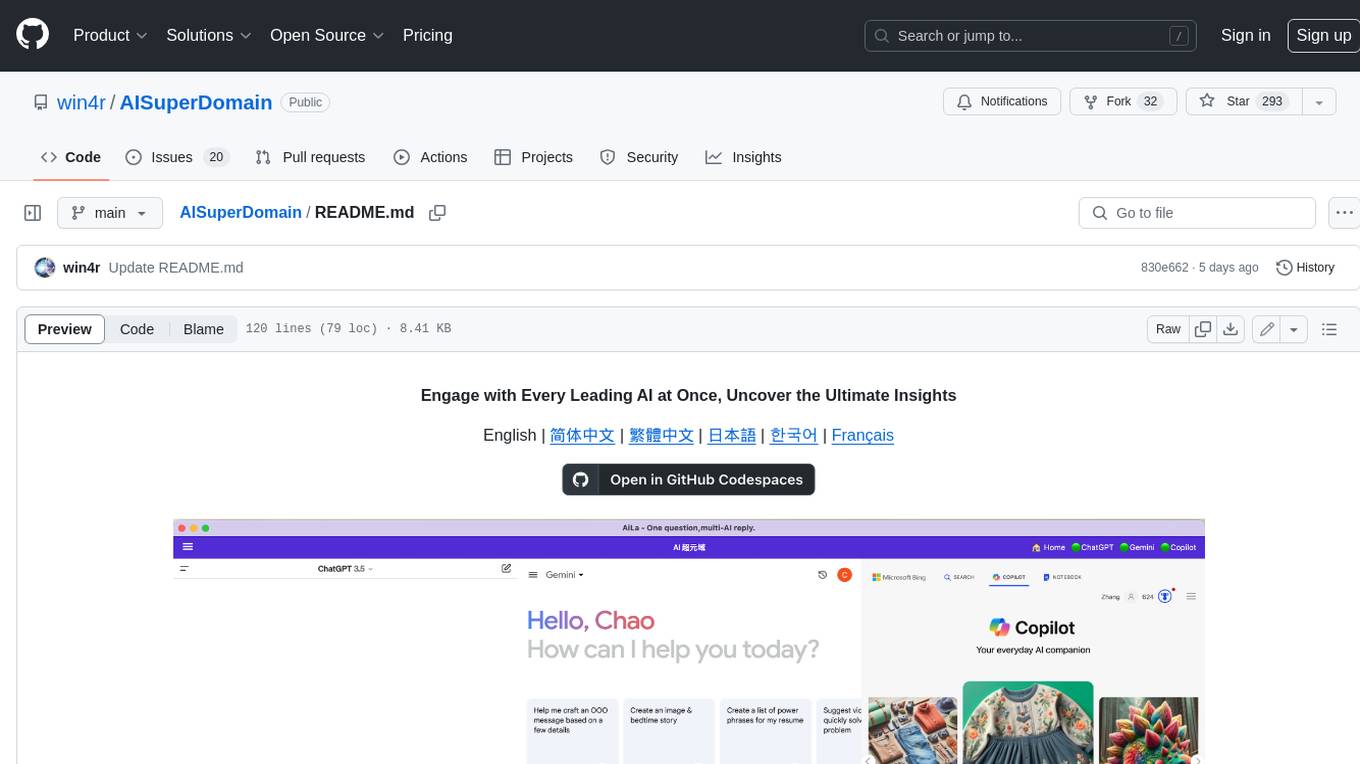
AISuperDomain
Aila Desktop Application is a powerful tool that integrates multiple leading AI models into a single desktop application. It allows users to interact with various AI models simultaneously, providing diverse responses and insights to their inquiries. With its user-friendly interface and customizable features, Aila empowers users to engage with AI seamlessly and efficiently. Whether you're a researcher, student, or professional, Aila can enhance your AI interactions and streamline your workflow.
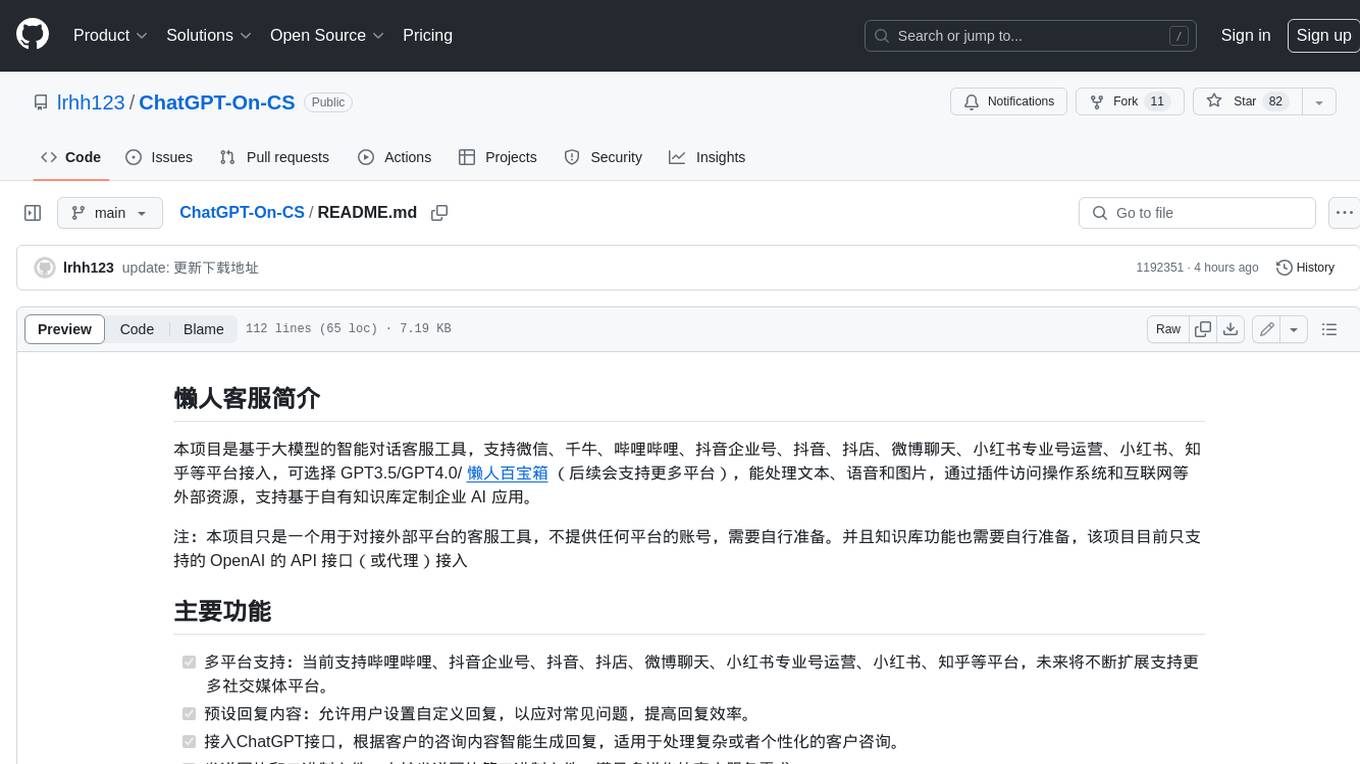
ChatGPT-On-CS
This project is an intelligent dialogue customer service tool based on a large model, which supports access to platforms such as WeChat, Qianniu, Bilibili, Douyin Enterprise, Douyin, Doudian, Weibo chat, Xiaohongshu professional account operation, Xiaohongshu, Zhihu, etc. You can choose GPT3.5/GPT4.0/ Lazy Treasure Box (more platforms will be supported in the future), which can process text, voice and pictures, and access external resources such as operating systems and the Internet through plug-ins, and support enterprise AI applications customized based on their own knowledge base.
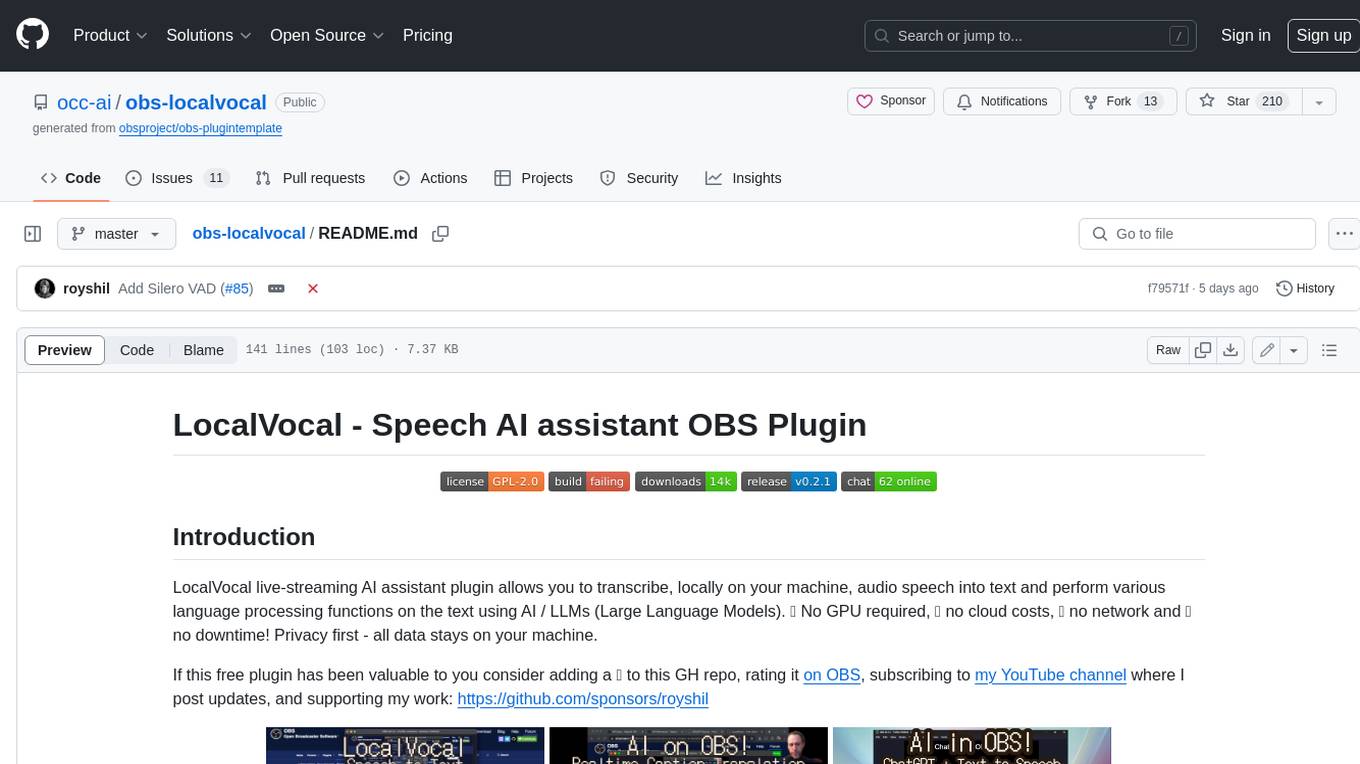
obs-localvocal
LocalVocal is a live-streaming AI assistant plugin for OBS that allows you to transcribe audio speech into text and perform various language processing functions on the text using AI / LLMs (Large Language Models). It's privacy-first, with all data staying on your machine, and requires no GPU, cloud costs, network, or downtime.